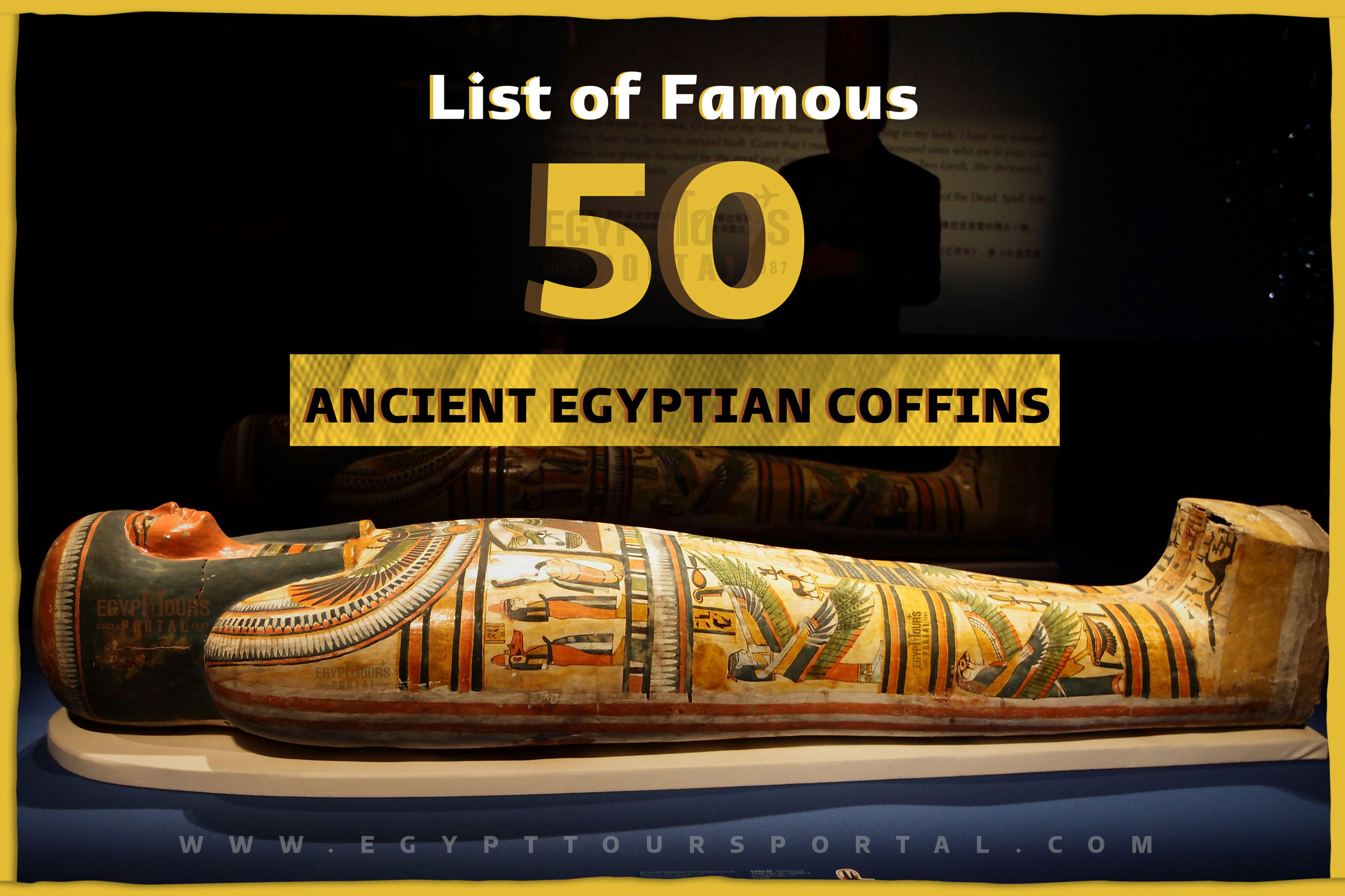
Ancient Egyptian Coffins were ancestral pieces of art that held magnificent meaning and played a central part in the ancient Egyptian religion that offered divine protection for the body after death. This eternal resting place was a vital factor in the funerary practices performed by the ancient Egyptians who adorned their coffins with intricately adorned with carvings, spells, religious texts, paintings, and depictions of the person's name, achievements, and even offerings in the hopes of having the honor of standing in front of the ancient Egyptian gods and goddesses.
The Egyptian sarcophagi were the key to acquiring awakening and offering a passage to the afterlife through the help of the components made of the coffin. The story and the aesthetics of coffins developed with time as it was the final piece of the mummification process that granted every soul a chance for completion. The ancient Egyptian coffins revealed a great deal of facts about the socioeconomic status and the social hierarchy that shaped Egypt and the coffins themselves.
Ancient Egyptian religion placed a strong emphasis on preserving the body after death, with mummification "The Opening of the Mouth Ceremony" and protection of remains being crucial for the deceased's transformation into a spiritual entity known as an "Akh" in the afterlife. To ensure this protection, individuals who could afford it utilized coffins to house their mummified remains, with these stone containers becoming integral components of burials from the Predynastic period to the Greco-Roman era. Coffins across the history of Egypt varied in material, such as wood, metal, or pottery, and workshops had diverse approaches. Throughout Egypt's history, different coffin types existed concurrently, more so in intermediate periods. During stable periods, coffin designs were more standardized.
During the entire history of ancient Egypt, one of the most crucial items purchased for ancient Egyptian tombs, whether for royalty or elites, was the coffin as it played the most important role which was to protect the body and prevent deterioration or harm. In the Predynastic era, bodies were wrapped in mats or furs and placed within containers like baskets, pots, or clay coffins. Wooden scaffolds around the body foreshadowed actual coffin construction.
Early ancient Egyptian Coffins served as eternal homes for the deceased and represented the eternal dwelling place of the deceased, reflecting architectural niches and the earliest coffins resembled miniature houses made from local wood pieces. By the Old Kingdom of Ancient Egypt (2700–2200 BC), coffins evolved into rectangular boxes with painted hieroglyphs and inscriptions, featuring the deceased's name, titles, food offerings list, a false door for the ka (spirit) to pass through, wadjet eyes for assistance in leaving the coffin and receiving offerings, and eyes for the deceased to see. Bodies were placed on the left side to align with painted eyes. Private individuals gained access to funerary texts during the Old Kingdom's end, leading to Coffin Texts inscribed on coffin interiors, securing passage to the afterlife.
Ancient Egyptian sarcophagus is a coffin-like container used to hold the mummified remains of the deceased in ancient Egypt. Read more facts!
Read MoreIn the Middle Kingdom of Ancient Egypt (2040 - 1782 BC), coffins of ancient Egypt became miniature tombs with rectangular coffins giving way to anthropoid (human-shaped) and winged "Rishi" styles during the Second Intermediate Period, adorned with items previously on tomb walls. Goddesses Isis and Nephthys guarded them, while the inside displayed Nut, Isis, Osiris, or the Djed pillar. The sides featured deities, and inscriptions included owner's details and prayers to divinities. Anthropoid coffins imitated the person's form, offering a substitute body if the mummy was lost, and they became more intricate over time.
Around 1650 BCE, Thebes saw the popularity of rishi coffins with feather-covered bodies, symbolizing Isis and Nephthys' wings. In the New Kingdom of ancient Egypt, private coffins merged anthropoid and Osiride shapes, along with offering formulas and texts. In the New Kingdom, ready-made coffins and mummy cases could be purchased and personalized. As history progressed, coffins responded to economic changes as Wealth and period influenced burial preferences, with one to three coffins nested together for certain individuals. at some times the Decorations simplified, cartonnage construction was introduced, and themes like the "Weighing of the Heart" and the "Embalming of Osiris" gained popularity. The Late Period saw wooden or stone coffins depicting large, smiling faces. In the Greco-Roman era, Hellenic influences transformed coffin styles and introduced the image of their foreign gods and their style.
Sarcophagi were often used to enclose coffins in tombs. Although the Greek term "Sarcophagus" means "Flesh Eater" the Egyptian interpretation was different. In their language, it could be called (neb ankh) "Possessor of Life". Other words for coffins and sarcophagi include "Wet" and "Suhet". "Wet" is possibly derived from "Mummy Bandage" and "To Embalm" while "Wetet" sounded similar to "to beget," implying rebirth from the coffin. "Suhet," used for "Inner Coffins" or "Mummy Board" also means "egg," symbolizing the emergence of new life. In preparation for rebirth after death, especially in the New Kingdom, wealthy Egyptians acquired a sarcophagus, a coffin (the mummy container or "That Which Begets"), and an inner coffin or mummy board (the egg).
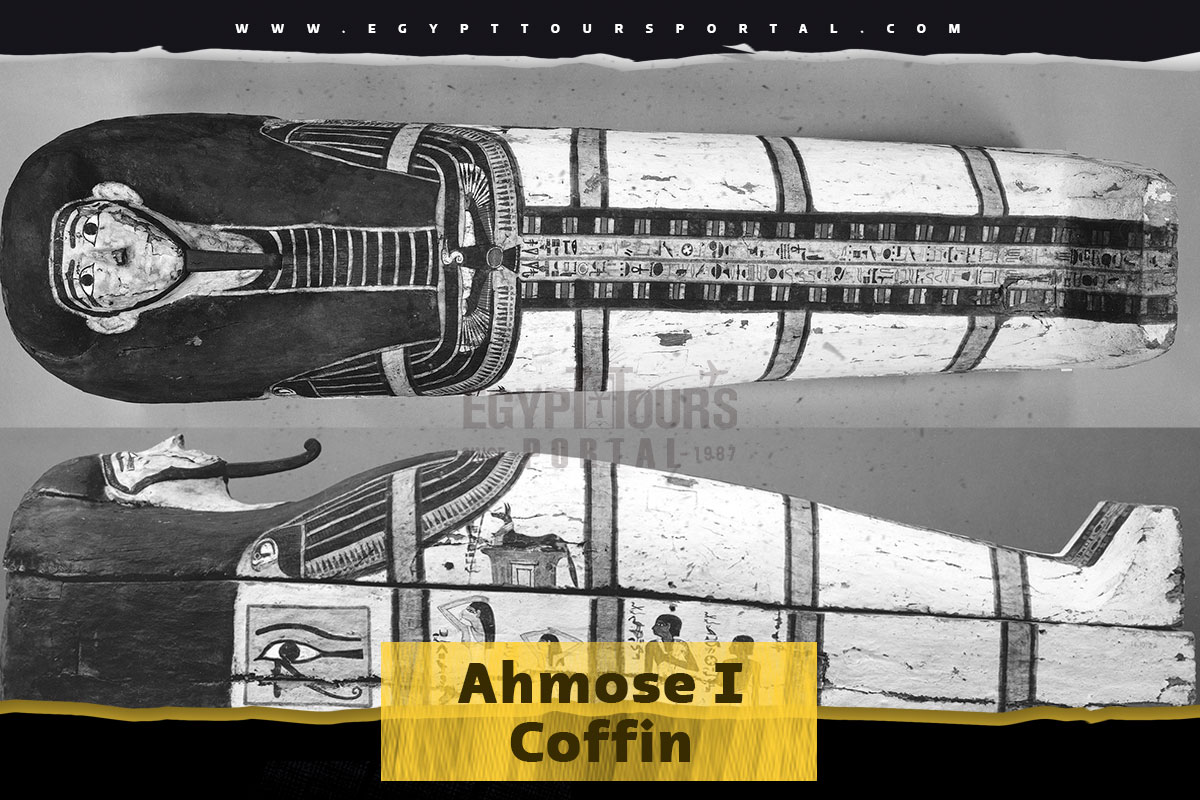
This marvelous coffin is dedicated to Ahmose founder of the 18th dynasty (1550 - 1292 BC), the son of Nakht "Lady of the House". It features intricate details such as a divine beard on his chin, a great collar with falcon-head terminals around his shoulders, and a marvelous winged vulture on his chest. The coffin is adorned with large eyes on its sides instead of the traditional Wedjat eyes. Ahmose's family members are depicted on both sides of the coffin, including his beautiful wife Hapu, daughter Ahmose, sons Mekyniwetef and Djehuty on one side, and Hapu with daughter Tet, sons Siamun and Nebseny on the other side. The foot end of the coffin is the image of the two sister goddesses Nephthys and Isis along with a male offering bearer. The lid of the coffin includes bands offering prayers, one directed towards the mortuary god Osiris and the other invoking the powerful stature god of the New Kingdom "Amun-Re".
What makes this coffin have artistic significance is made clear through this great piece of art as it shows that during the early New Kingdom, the design of coffins changed from the rishi style of the Second Intermediate Period to anthropoid coffins made from large planks covered in stucco and painted white. These anthropoid coffins had vertical and transverse bands on the lid and trough, symbolizing the linen wrappings that enveloped the mummy. This connection between the bands and the wrappings identified the coffin as a vessel for the spiritual essence believed to endure after death. The bands also mirrored architectural elements from earlier rectangular coffins, emphasizing that the coffin was the everlasting abode for the deceased individual.
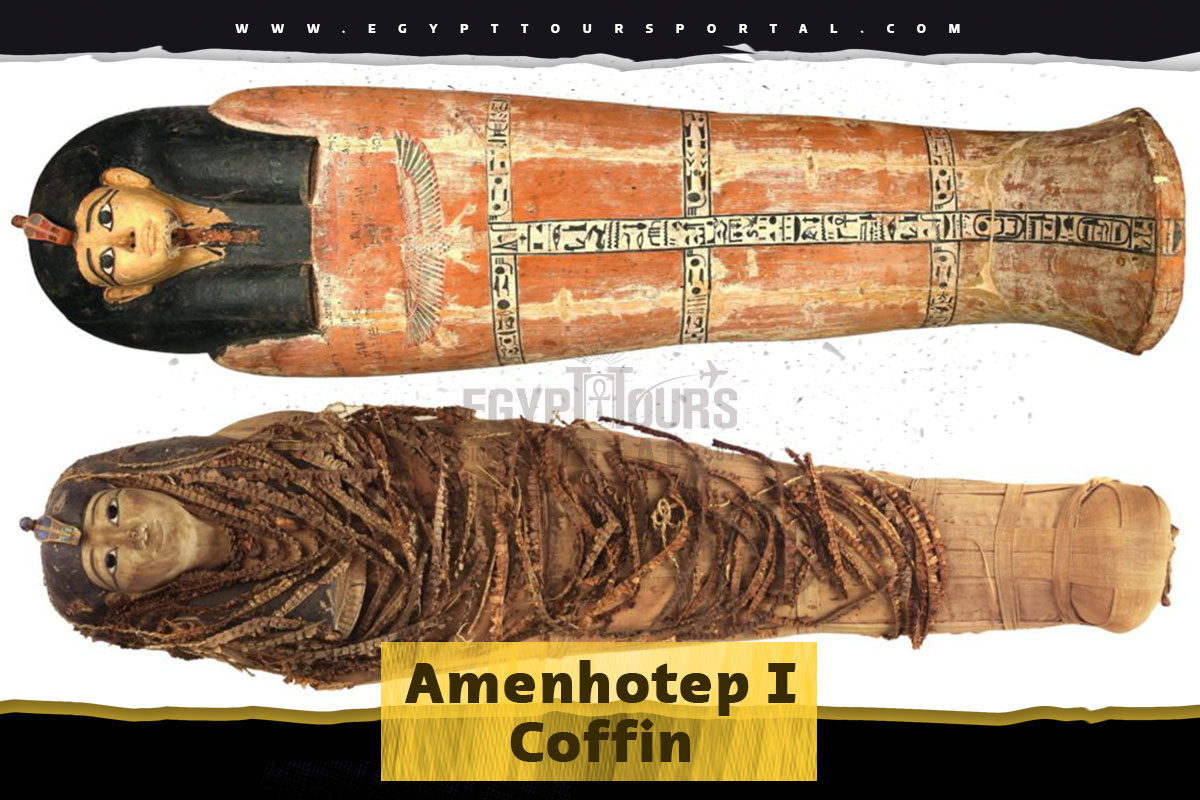
Amenemope "1525–1504 BC" held the titles of "God's Father of Amun" and "Scribe of the Double Treasury of the Lord of the Two Lands and the House of Amun". He was buried in two coffins that are believed to originate from Sheikh Abd el-Qurna in Western Thebes.
Both the inner and outer coffins share similar shapes and decorations. The lids of these coffins feature finely crafted faces with the characteristic curved beards of deified individuals. The hands are visible, holding document case "Mekes" associated with royalty. The figures are depicted as slim with prominent kneecaps, draped in a bright red cloth called "Stola" which encircles the whole neck and emerges beneath folded arms. Scholars have identified these features, along with the oversized collar and make, as belonging to the time period between 975 and 909 B.C. The miniature figural designs on each lid are meticulously executed in a colorful palette. They mostly depict scenes of adoration and presentation. The gods are often shown in raised relief, while the deceased is portrayed using painted lines. The outer box's interior decoration showcases various scenes of religious and emblematic nature, all centered around Amenhotep I. The inner coffin's interior also features additional depictions of the same king, although some areas are smudged due to embalming fluid.
The Coffin of Amenhotep I might have originally been covered in gold, but it's likely the gold was removed by ancient authorities who cleared tombs. The remaining decoration might have been added later after the gilding was removed. The figure on the coffin wears a black divine headdress with a wooden uraeus on the forehead, representing the protective goddess Wadjet. Kneeling figures of Isis and Nepthys are depicted on the headdress, symbolizing protection for the deceased king. Amenhotep I's face was painted yellow to resemble gold, and a missing divine beard likely once adorned the figure. A vulture pectoral is painted on the chest, accompanied by hieroglyphic texts of the traditional offering formula. The interior is coated with black varnish or resin, not visible in the model. The exterior sides show drips of this material applied during manipulation. The sides of the coffin display wadjet eyes, and faded figures representing the Four Sons of Horus and the god Thoth.
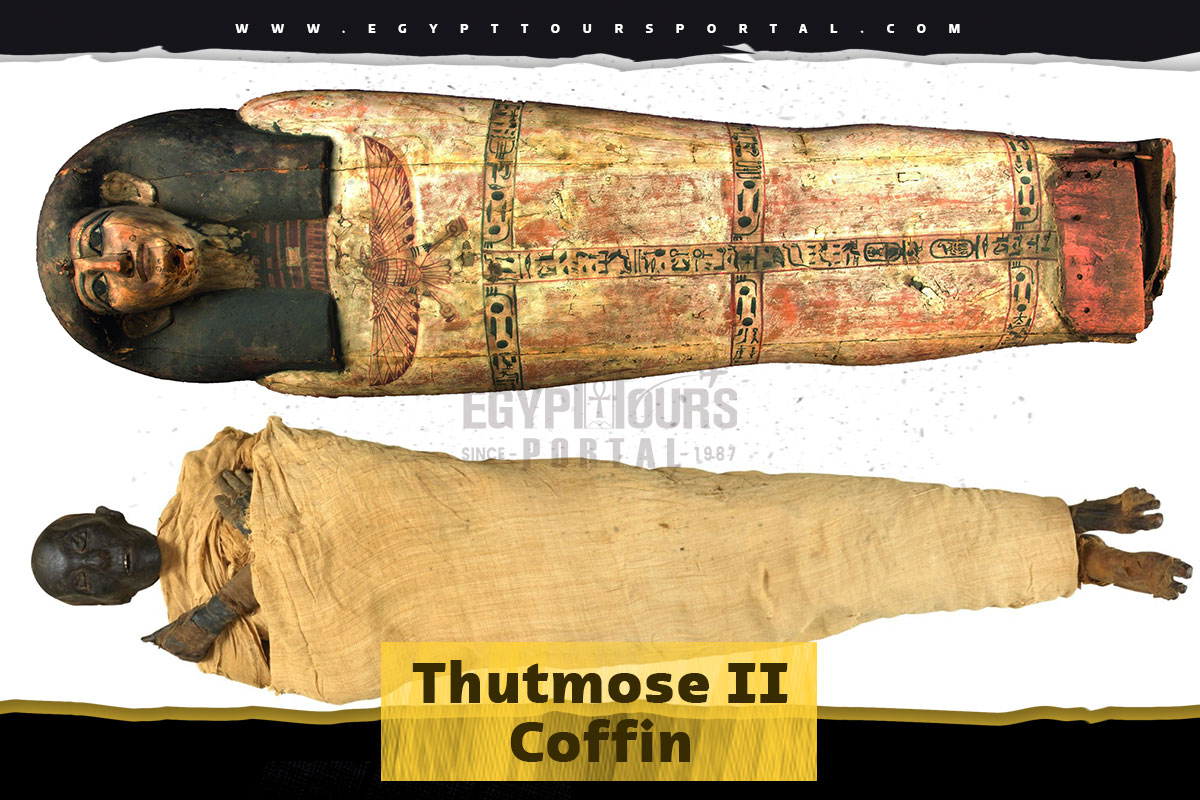
Situated in the Valley of the Kings in Luxor, the Tomb of Tuthmosis II (1493–1479 BC) (designated as KV 42) which is part of the Royal Cache known as TT320 raises uncertainty about whether it indeed served as the king's final resting place. The tomb lacks ornamentation and features an incomplete and unpolished sarcophagus positioned within its burial chamber shaped like a cartouche. However, Tuthmosis II's mummy and coffin were discovered within the mummy cache of TT 320.
Inside the cartouche-shaped burial chamber, an unfinished stone sarcophagus lay with its lid supported by a wooden piece. The King's titles were inscribed in black paint on yellow bands that encircled the coffin and ran down its center. In 1886, Tuthmosis II's mummy was unveiled which was evident that tomb raiders had inflicted considerable damage on the body to rob it of all its priceless treasures.
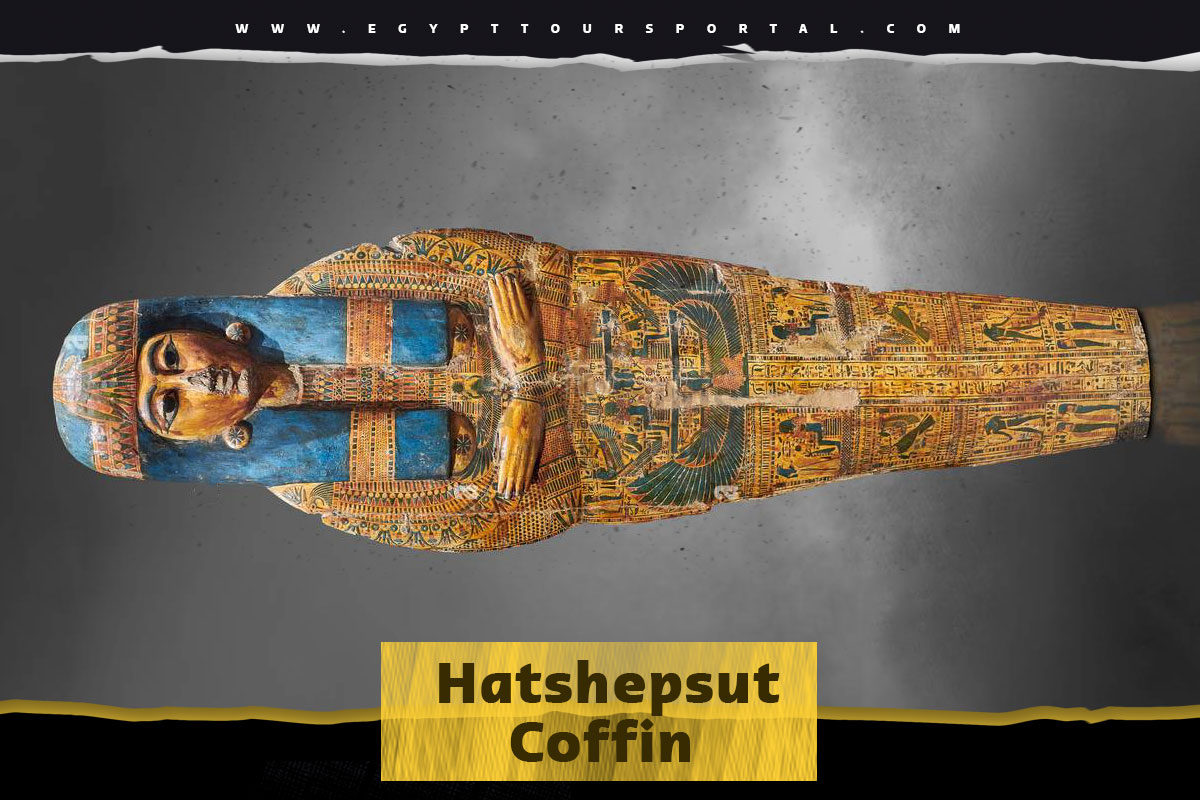
The sarcophagi used for the burial of Dynasty 18 kings were made from quartzite or red granite, stones associated with the sun and rebirth. Red paint was applied to enhance the color and fill the hieroglyphs. An exceptional example is Hatshepsut's royal sarcophagus, originally intended for her but later retrofitted for her father Thutmose I. The inscriptions were changed to accommodate Thutmose I, demonstrating Hatshepsut's devotion.
The sarcophagus proved too small for Thutmose I's mummy, leading to alterations. The sarcophagus displays exterior and interior faces featuring human-headed deities, including protective canopic deities and the four sons of Horus. Book of the Dead Chapter 72 is inscribed on the right interior side. The left interior side showcases the goddess Nut's embrace, extending up the sides of the sarcophagus.
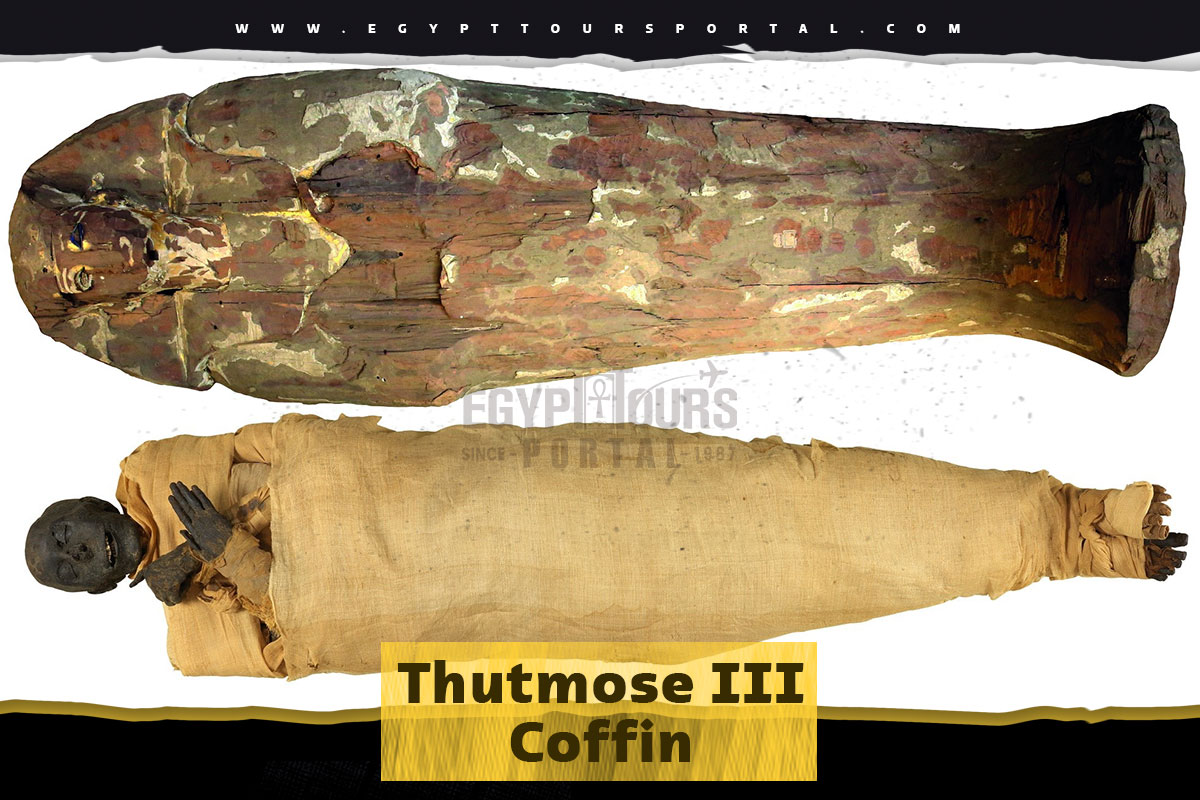
Thutmose the Great, ruling from 1479 to 1425 BC, possessed a unique sarcophagus with an anthropoid shape and a distinctive one-piece design, unlike traditional prototypes. It was core-built and stood out among model sarcophagi. Sadly, robbers during the 20th dynasty removed his mummy from the coffin, taking its jewels. The wooden mummiform coffin that contained his body was original but had lost any gilding or decoration due to ancient damage.
The coffin features an opaque turquoise-blue glass body. On one side are four standing deities in yellow glass relief, enclosed by dark-blue glass borders. The other side holds three standing deities in yellow glass, with two yellow glass Wedjat-eyes in place of a fourth deity. Yellow threads on the lid likely outlined an intended inscription that was never added. A Nekhbet-vulture or falcon in Dark-blue and yellow glass adorns the breast area. Traditional bandages in opaque white and translucent dark-blue glass are present, applied using trailing. Original wig banding can still be seen. A foreign gypsum plaster yellow face, likely a modern addition, has replaced the lost original. An ancient hole in the feet allowed core removal and the insertion of a votive item.
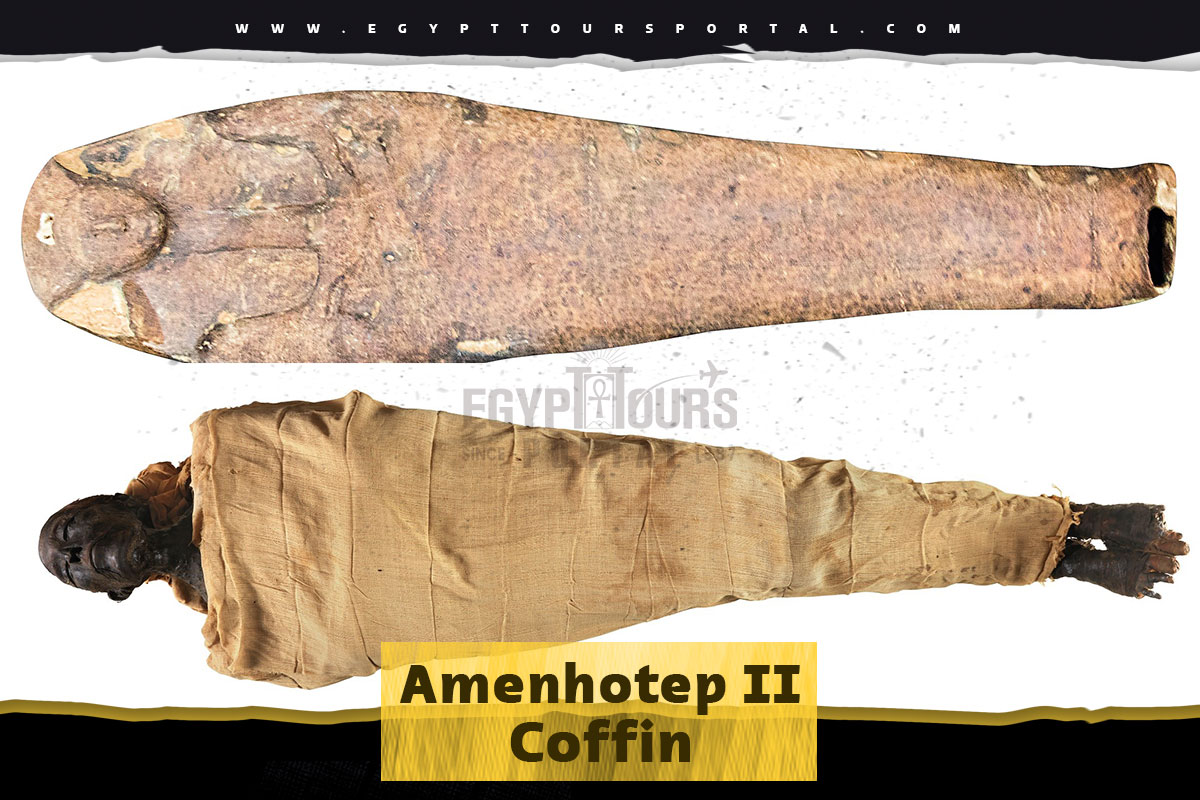
The quartzite sarcophagus Sarcophagus of Pharaoh Amenhotep II (1424-1397 BC) is found in the lower level of his final resting place at the Valley of the Kings. Despite the tomb being looted, the royal mummy remained within in a remarkably well-preserved condition which is adorned with a wreath of flowers. Just like Thutmes III's sarcophagus, it was painted to mimic the appearance of granite.
Surrounding the sarcophagus, there are 4 small rectangular holes cut in the lower part of the burial chamber; two of them in the rear wall and one on each side of the rear face of the last pair of pillars. The brick niches are designed to hold small mud bricks bearing inscriptions or paintings of part of spell 151 from the Book of the Dead, often accompanied by depictions of a jackal, a mummy, or the hieroglyph for "Ro Endure". A segment of the inscription reads, "I have come as your protection, and my protection will be about you forever".

The remains of Amenhotep III's sarcophagus consist solely of the red granite lid, measuring 3 meters in length. It was discovered in fragments within the burial chamber, and it's uncertain if the main part of the sarcophagus was also made of red granite or a different contrasting material, like quartzite.
During the 21st Dynasty, due to the plundering of the necropolis, priests of Amon relocated the mummy, including Amenhotep III's, to Amenhotep II's tomb (KV35). Victor Loret rediscovered this mummy in 1898, though it was found severely damaged, with the head even broken off. The wooden internal sarcophagus was better preserved. The mummy's identity was verified through a docket on the shroud. The confusion arose during the transfer to KV35, where Amenhotep III's mummy was found with the lid of Sety II's coffin and the coffin box of Ramesses III. Notably, the identification of several royal mummies, including Amenhotep III's, is now uncertain.
Fragments of Amenhotep III's calcite canopic chest were found in the burial chamber, hinting at a similar range of grave goods to Tutankhamun's tomb. It's unclear if his wives, Tiy or Sitamon, were buried in KV22, but Amenhotep III's presence is reasonably certain.
Some sections of the tomb, vandalized in modern times, are now housed in the Louvre Museum. Their exact origins are currently unknown, yet they exhibit Amenhotep III's distinctive artistic style, characterized by large, almond-shaped eyes raised towards the ear end.
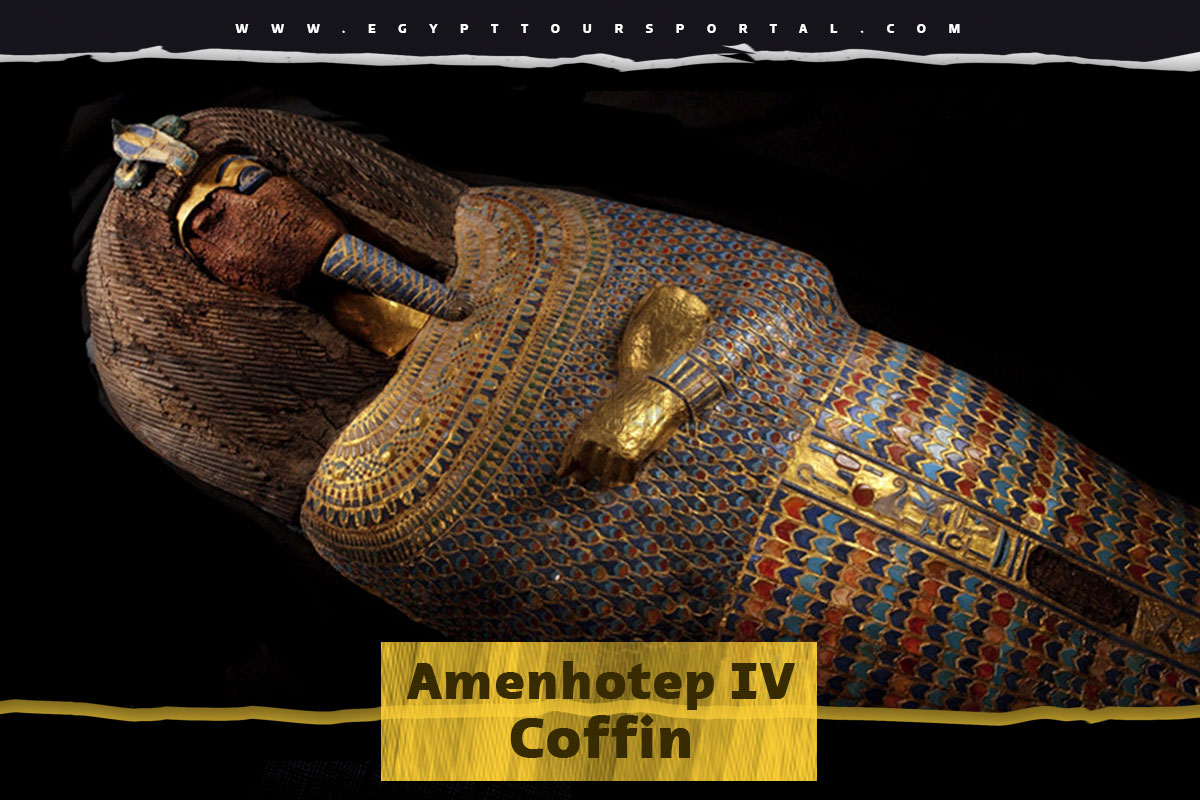
The gilded and inlaid wooden coffin from KV55, has its face and the cartouche containing the occupant's name intentionally damaged in antiquity. This damage strongly indicates that the body within the coffin likely belongs to Akhenaten.
There is a lot of mystery that surrounds the coffin of Akhenaten (1353–1336 BC) as when his tomb KV55 was opened, it was believed that it belonged to Queen Tiye's tomb. However, the remains found there were male, leading to the conclusion that the gilded coffin, originally made for a woman, was altered for a king. The false beard, uraeus, and royal scepters were added later. Various candidates like Tiye, Nefertiti, Meketaten, and Meritaten were considered for the coffin's original owner. It's now widely agreed that the coffin was intended for Akhenaten's secondary wife, Kiya. The nearby canopic jars, with female heads on the stoppers, also belonged to Kiya but were altered for a king.
The identity of the remains inside the coffin has been debated due to erased names. Candidates included Akhenaten and Smenkhkare, another Amarna family member. The presence of four magical bricks in the tomb provides evidence for Akhenaten's identity. Two hieratic-inscribed bricks are damaged, while the others, inscribed with hieroglyphs referring to "Neferkheprure Waenre", link to Akhenaten's women. All four bricks, positioned near the coffin, imply they were intended as a set, suggesting that Akhenaten is likely the final occupant of the coffin.
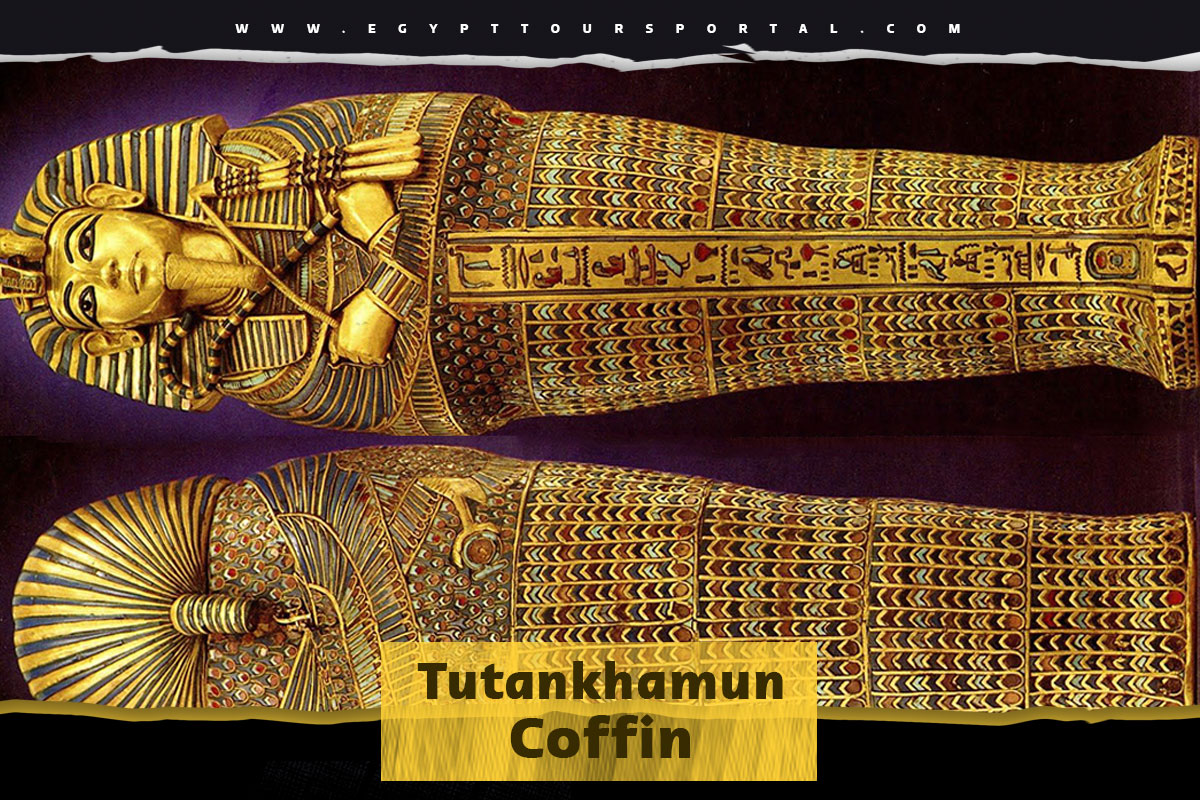
Tutankhamun (1341 BC – 1323 BC) famously known as the Golden Boy Pharaoh, reigned during the 18th Dynasty of the New Kingdom. Renowned for his intact tomb and valuable funerary artifacts, his premature death has long intrigued people worldwide.
Interred within his tomb (KV62) situated in Luxor's Valley of the Kings on the west bank, Tutankhamun's resting place was unveiled by British archaeologist Howard Carter in November 1922, generating significant global attention. The burial chamber, measuring 6m x 4m, held the outermost rectangular quartzite sarcophagus (a box-like stone container) that held three coffins within each other like a Russian doll adorned with figures of protective deities at its corners. Three nested anthropoid coffins inside depicted the king in the Osirian pose.
The Innermost Gold Coffin, weighing 110.4 kg, is mummy-shaped and crafted from solid gold. Found within the middle coffin, both are displayed at the Egyptian Museum Cairo. Encased within it was the king's mummy, topped by the iconic gold mask. The Middle Gilded Coffin, featuring gilded wood with multicolored glass inlays, was discovered within the outer gilded coffin. The Large Outer Gilded Coffin, fashioned from gilded wood, portrays Tutankhamun in Osirian form, holding the flail and crook with glass-adorned insignia. Silver handles aid in moving the lid. It measures 223.5cm in length, 83.8cm in width, and 105.5cm in height. The coffin carries the depiction of the pharaoh embodying a divine likeness as Gods were believed to possess skin of gold, bones of silver, and lapis lazuli hair. In his divine afterlife form, the king is presented in this manner. He grasps the crook and flail, symbols of his rightful rule. Adorned with semi-precious stones, the goddesses and extend their wings over his body. Below, two additional goddesses, and, are intricately etched into the golden lid.
One of the essential parts of the coffin and by far the most enchanting is the death mask which is celebrated as the ultimate masterpiece of ancient Egyptian art, originally placed directly on the mummy's shoulders inside the magnificent innermost gold coffin. Created from two great sheets of gold hammered together, it weighs 22.5 pounds (10.23 kg). Tutankhamun is portrayed wearing the striped nemes headdress, along with the goddesses Wadjet and Nekhbet safeguarding his brow. A false golden beard, like that on the inner coffin, emphasizes his divine resemblance. The mask includes a broad collar with falcon head-shaped terminals. On the mask's back is a Spell from the Book of the Dead numbered 151b, serving as a guide for the afterlife. This specific spell safeguards Tutankhamun's limbs during his journey into the underworld. In 2019, the outer coffin was transported to the Grand Egyptian Museum (GEM) for restoration and display. The GEM will be exhibited alongside the inner and middle coffins as part of Tutankhamun's esteemed collection found in his own mega-personal hall.
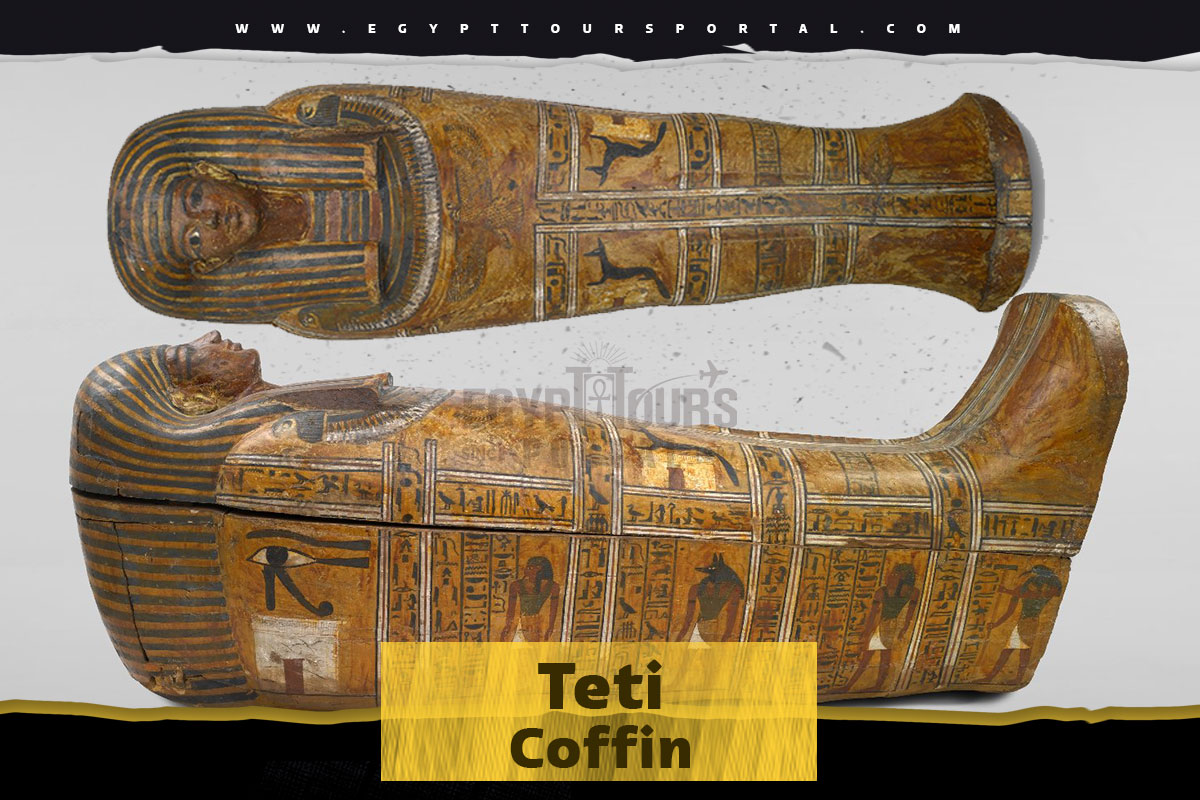
The coffin of Teti dates back to 2323–2291 BC which was uncovered in an area of western Thebes called Birabi or lower Asasif. This burial site was in use until early Dynasty 18 before being covered for the construction of a valley temple near Hatshepsut's mortuary temple at Deir el-Bahri. The coffin is likely from the late days of the 17th or early days of the 18th Dynasty which is a sizable rectangular structure with a slightly arched lid. It's crafted from assembled planks and sycamore wood remnants. Its decoration showcases checkerboard patterns in black and red on the long sides, supplemented by roughly painted scenes.
One side portrays female mourners facing an offering stand and various offerings, while the other illustrates a funerary boat ship journeying to Abydos and offering bearers in two registers. On the head end stands the goddess Isis atop a shrine, with added wood above containing Wedjat eyes. The mortuary gods Anubis and Nephthys are depicted in jackal form at the foot end. An inscription band on the lid presents an offering prayer dedicated entirely to Teti. within the coffin, two adult mummies and one child were discovered, along with a faience bowl and a scarab.
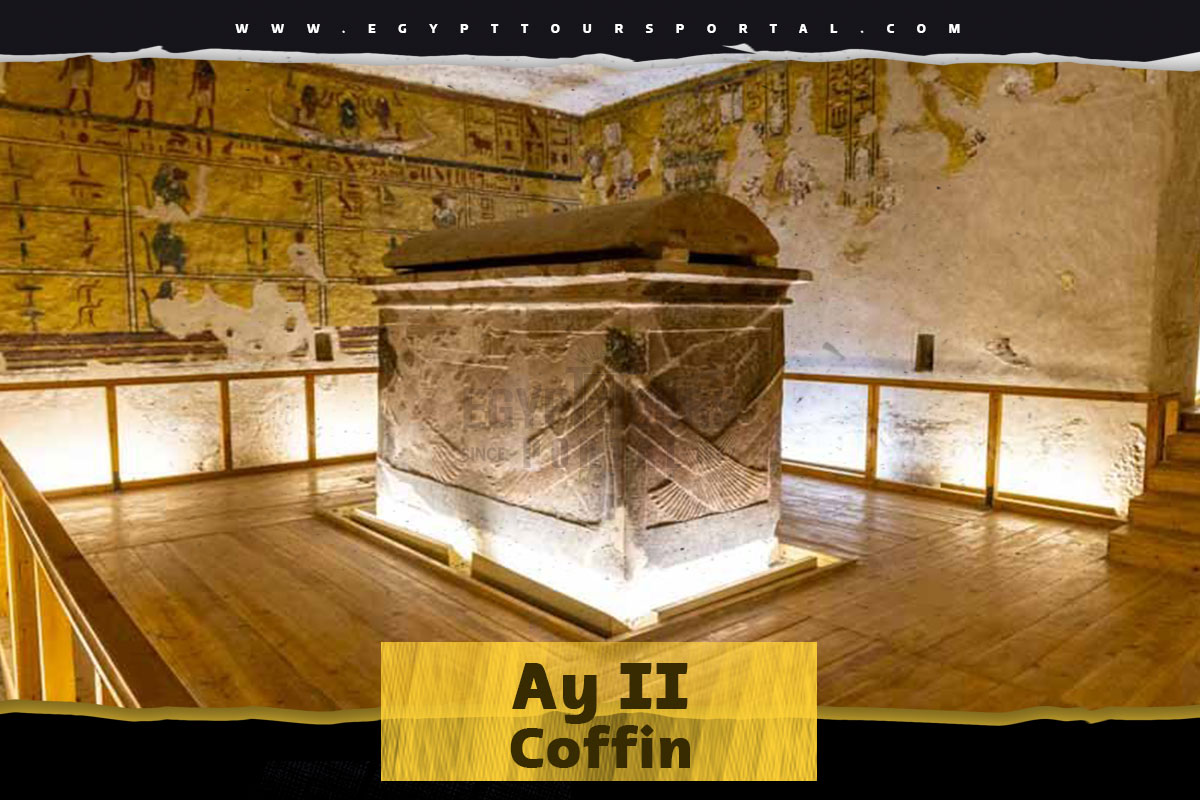
The discovered tomb that held the coffin of Pharaoh Ay 1323–1319 BC was extensively shattered into fragments, lacking its lid. The reassembled box section was taken to the Cairo Museum and later returned to its original position, albeit reversed, in 1994. Some pieces are still in Berlin and the British Museum. The lid was eventually found by Otto Schaden in 1972, lying face down in the chamber's debris, with unerased king's cartouches and others on the box, possibly due to its impending destruction.
The sarcophagus, made of red granite, is shaped like an Upper Egyptian shrine (pr wr), measuring 2.96 x 1.20m and 1.79m in height. The interior is inscribed with Book of the Dead texts. Its external sides feature the protective goddesses—Isis, Nephthys, Neith, and Selkis—with extended wings on the corners. Two winged solar disks adorn the long sides. The rounded lid bears a column of text, centered around the king's cartouches, which were not obliterated. Two Udjat eyes are visible at the end.
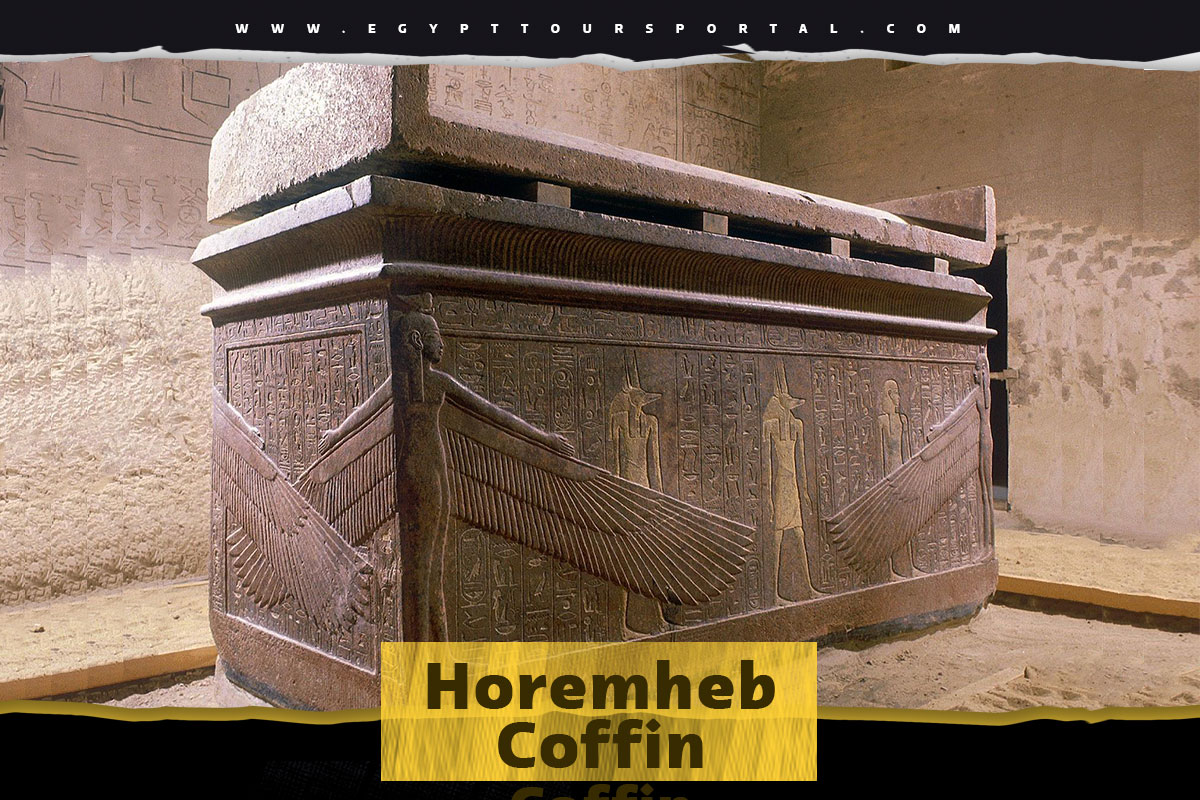
During ancient Egypt's 18th Dynasty (1550–1295 BC), Horemheb, the final pharaoh, possessed an impressively preserved red granite sarcophagus located within the northeastern corner of the Sarcophagus Chamber. Slightly offset from the center, this sarcophagus boasts dimensions of 2.72 meters in length, 1.15 meters in width, and 1.41 meters in height, inclusive of its lid. Positioned with its elongated side facing the northern wall, the principal box exhibits intricate relief carvings that have weathered the passage of time fairly well, despite minor abrasions attributed to ancient pilfering. A decorative Egyptian cornice elegantly graces the upper edges of the box. The lid, also hewn from red granite, showcases three slots meticulously carved for wooden cramps, a testament to ancient attempts at repairing a diagonal split. Its design mimics the form of a vault, characterized by rectangular block ends.
Horemheb, the solitary king from the 18th Dynasty desired to incorporate the Books of the Netherworld and purposefully directed the head of his sarcophagus toward the east. Each terminus of the elongated sides of the sarcophagus highlights goddesses adorned with outstretched arms, their expansive wings serving as support. These goddesses are depicted in raised relief: Isis occupies the northeast corner, facing Neith in the northwest corner, while Nephthys stands in the southeast, facing Selkis in the southwest. On the elongated sides, a trio of deities grace each side, positioned between the wingtips and midway between the central deity and the terminal goddess. Positioned so as to be partially concealed by the wings, these gods play a pivotal role. On the north-facing side, the deities include Hapy, Anubis, and Qebehsenuef. The south-facing side features Amseti, Anubis, and Duamutef. This arrangement strategically places the four sons of Horus at the corners of the deceased's resting place, in the company of the goddesses. The lid bears inscribed text, meticulously arranged to evoke the imagery of bandages swathing the sarcophagus. These bands of text traverse the lengthy sides, extend centrally along the length, and cascade gracefully over the curved apex at the ends, composing a visual motif reminiscent of bandaging.
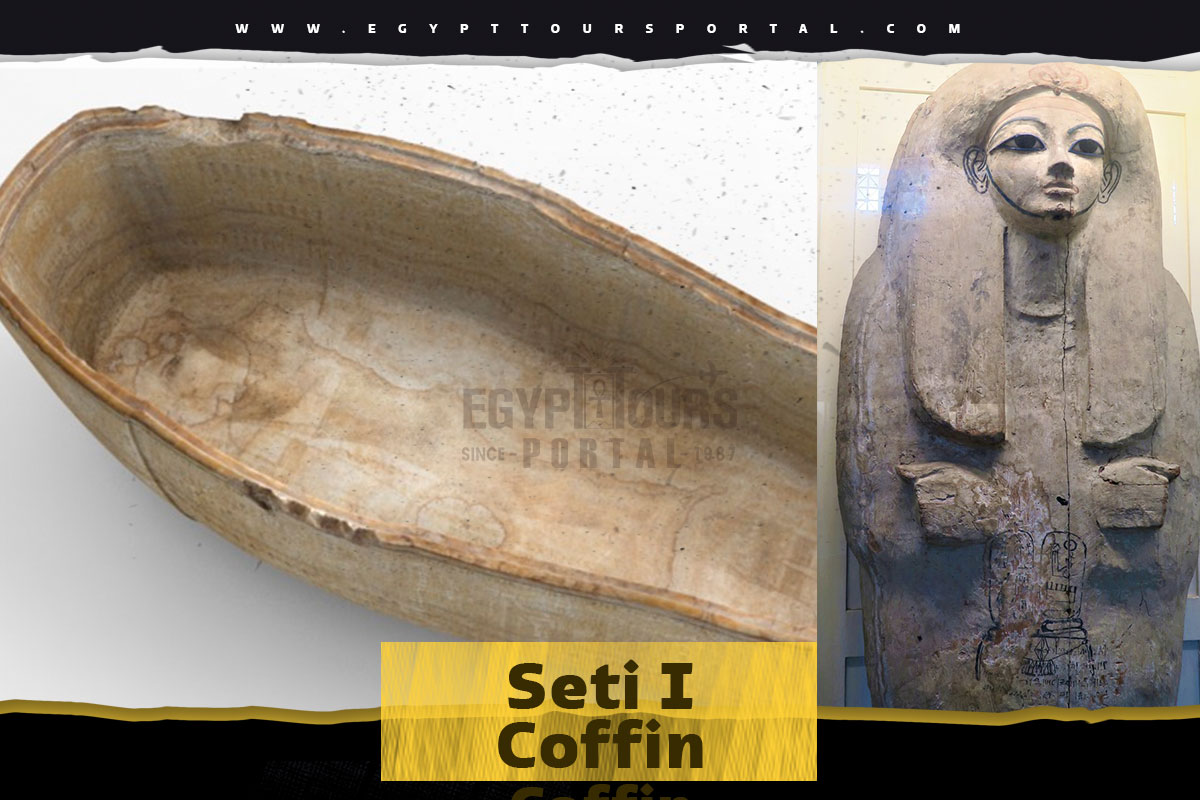
The Seti I Sarcophagus is made of Alabaster with Egyptian blue infill with the dimensions of:
The life-size sarcophagus of Seti I, a pharaoh from the 19th Dynasty, was unearthed in 1817 by Italian explorer Giovanni Battista Belzoni within tomb KV17 in Egypt's Valley of the Kings. Believed to have died in 1279 BC, Seti I's sarcophagus was designed to house his coffin and mummy. Carved from a single large slab of white stone, this impressive piece measures 10 feet (3 meters) in length and exhibits a translucent quality when internally illuminated. Both its interior and exterior bear inscriptions detailing Seti's titles and passages from the Book of the Gates. The base of the sarcophagus features a portrayal of the goddess Nut, symbolizing the sky.
The interpretation of the hieroglyphs on the sarcophagus posed challenges due to the early stage of hieroglyph research. After being declined by the British Museum due to the high price requested by Belzoni, architect Sir John Soane acquired the sarcophagus in 1824 for £2000 (equivalent to £187,000 in 2021). It currently resides in the crypt section, known as the Sepulchral Chamber, within Sir John Soane's Museum in London. This sarcophagus, over 3000 years old, stands as one of the United Kingdom's oldest museum artifacts in public collection.
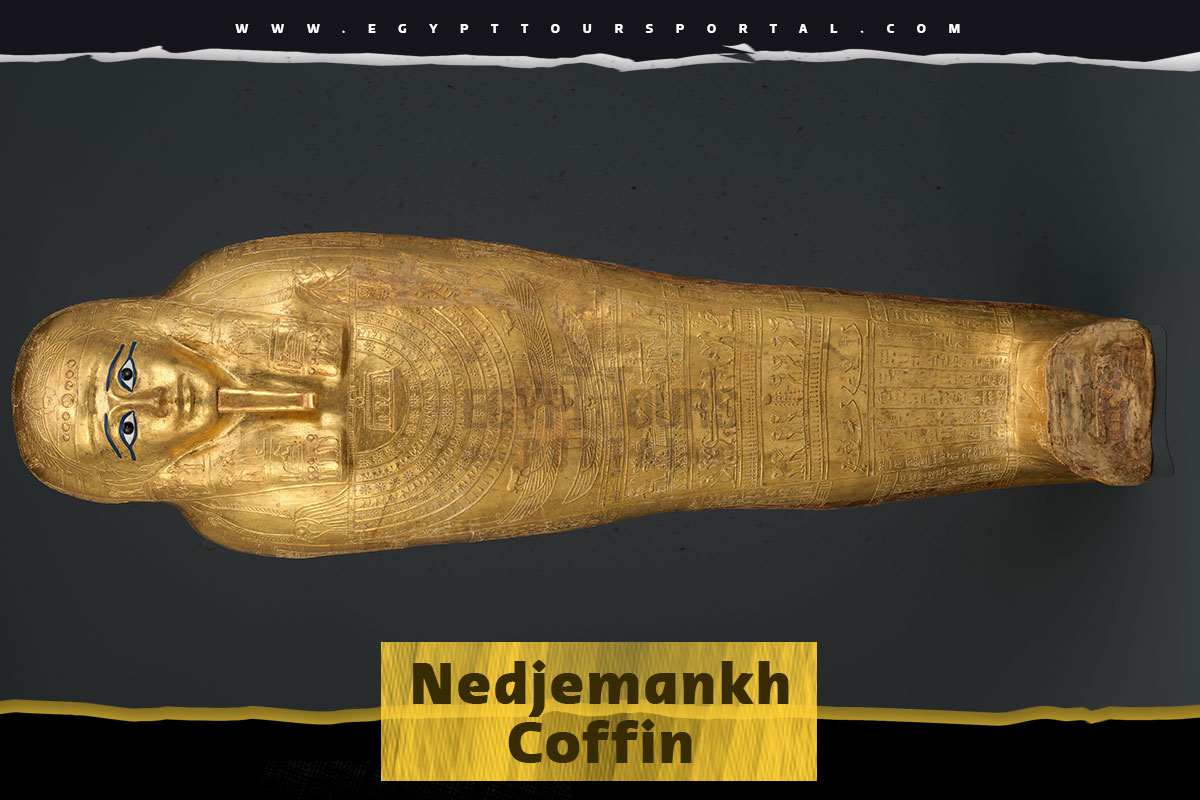
The magnificent gilded ancient Egyptian coffin of Nedjemankh who is a priest of the ram god Heryshaf from the late Ptolemaic Period, measures 181 cm in length, 53 cm in width, and 28 cm in depth. Crafted from a mix of materials including cartonnage, paint, silver, wood, resin, gold, glass, and leaded bronze, the coffin features vignettes from the Book of the Amazing Dead on its lid. These depict rituals in the hall of truth like the weighing of the heart against Ma'at in front of Osiris and the embalming of the mummy, along with a marvelous inscription invoking elements of gold and silver. Inside, a figure of Nut, the sky goddess, is partially covered in silver foil.
The coffin's base carries a Djed pillar hieroglyph, symbolizing stability and the backbone of Osiris, ensuring resurrection in the afterlife. Nedjemankh's title as a priest is inscribed on the coffin, reflecting his dedication to Heryshef. Ancient Egyptians saw coffins as homes for the deceased's spirit, prompting meticulous decorations and inscriptions. Nedjemankh emphasized the theme of silver and gold, embedding a hymn about these precious metals and adorning the coffin with gold and silver. This aimed to elevate his physical body and spirit to a divine level, mirroring the gods in the afterlife. In 2019, the Metropolitan Museum repatriated Nedjemankh's coffin to Egypt, entrusting it to the Antiquities Repatriation Department of the Egyptian Ministry of Antiquities ahead of the exhibition's closure.

Ramesses II's striking royal coffin, dating from the late 18th Dynasty, stands out as a remarkable discovery from ancient Egypt. Crafted from high-quality imported wood, the coffin was meticulously reworked for the reburial of Ramesses II during the New Kingdom's decline. Found within the Royal Cache at Deir el-Bahari (TT320) in 1881, it sheds light on the complex burial practices of the time. This coffin, despite its original adornments being removed, remains a testament to ancient craftsmanship. Measuring 181 cm in length, 53 cm in width, and 28 cm in depth, it is made of cartonnage, paint, gold, silver, resin, glass, wood, and leaded bronze. Intricate hieratic texts and depictions of funerary rituals adorn the lid, including the weighing of the heart and mummy embalming. Notably, dockets or records of the official caching, written in hieratic, indicate the movements of the coffin and its occupant. Two large cartouches on the lid reveal Ramesses II's birth and throne names.
The journey of Ramesses II's mummy revealed through the inscriptions, shows that it was relocated from his initial tomb (KV7) to the tomb of his father, Seti I (KV17). Afterward, it was moved to Ahmose-Inhapi's tomb before finally being transferred to the Royal Cache at TT320. The coffin carries depictions of Ramesses II, with a nemes headdress and symbolic crossed arms holding a crook and flail. The divine beard symbolizes his transformation into a deified being in the afterlife. The coffin's uraeus (cobra), representing the protective goddess Wadjet, underwent modifications, indicating its original adornments were stripped, likely including gold and precious materials. This suggests a rich dual vulture-cobra motif similar to those on Tutankhamun's artifacts. The coffin itself may not have been Ramesses II's original burial container; its elongated, triangular face suggests it could have belonged to Horemheb, the last ruler of the 18th Dynasty. Nonetheless, the coffin stands as a captivating artifact, revealing intricate burial practices and the intricate connections between royal coffins and their occupants during ancient Egypt's final stages.
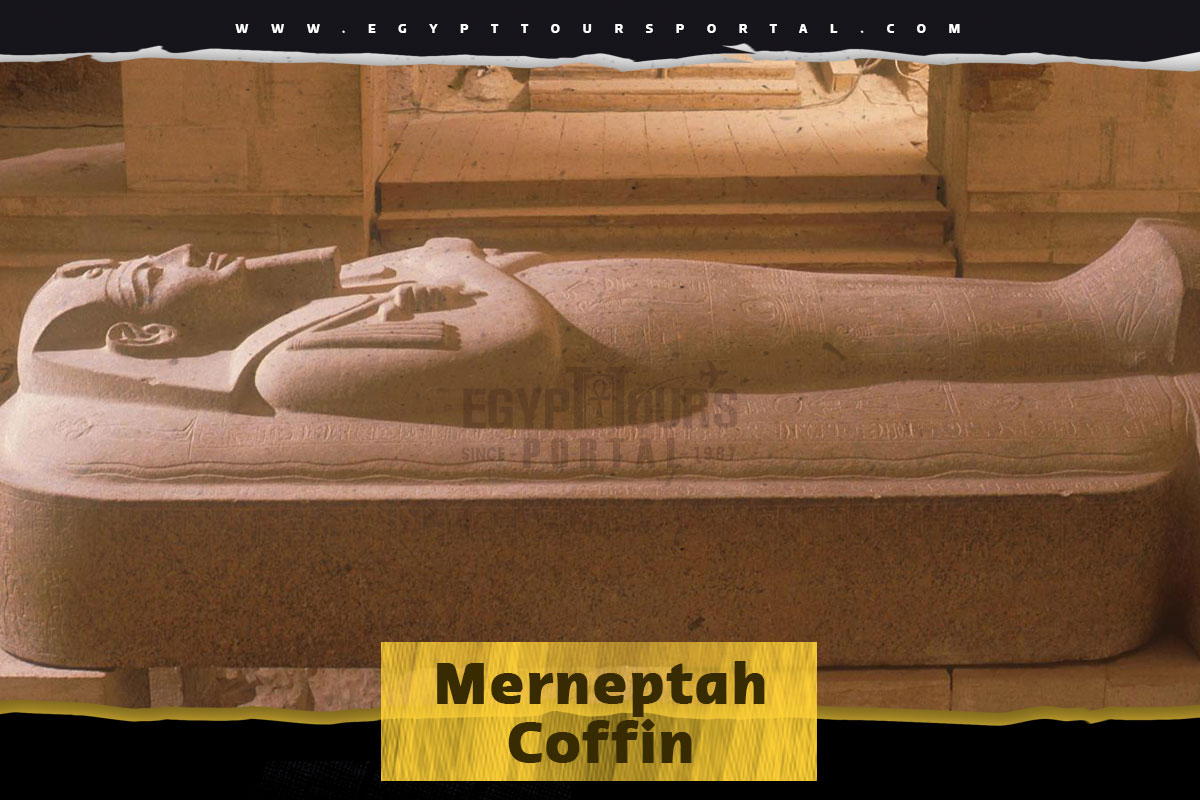
Pharaoh Merneptah's colossal sarcophagus stands as a testament to the skill of the ancient Egyptian builders. His mummified remains were enshrined within a sequence of four nested sarcophagi, each progressively larger than the last. The outermost casing, a masterpiece of craftsmanship, boasts dimensions of 13 feet in length, 7 feet in width, and a towering height of over 8 feet. Despite having endured fragmentation due to its fiery demise and subsequent shattering some 3,000 years ago, diligent researchers are meticulously reconstructing and restoring this colossal burial receptacle. Their efforts aim to resurrect the grandeur that once enveloped the largest ancient Egyptian sarcophagus ever commissioned.
This monumental red granite sarcophagus, an unparalleled marvel found within Egypt's Valley of the Kings, was meticulously crafted for Merneptah, a formidable Egyptian pharaoh whose reign spanned over 3,200 years. Renowned for his warrior prowess, Merneptah triumphed over the Libyans and the enigmatic "Sea Peoples" in a monumental battle. His campaigns also extended into the Levant, including an encounter with a group referred to as "Israel" in one of the earliest recorded mentions of this people. Upon his death, the elaborate ritual of entombment commenced, encapsulating his mummy within a series of four stone sarcophagi, each nested within the other. The meticulous reassembly of the outermost sarcophagus, an endeavor of remarkable proportions, mirrors the splendor of the original creation. Stretching over 13 feet in length, 7 feet in width, and soaring more than 8 feet into the air, the sarcophagus is a colossal masterpiece that once bore vibrant hues and retains its intact lid.
Merneptah's choice to employ four successive sarcophagi might be gleaned from the intricate decorations adorning them. Enriched with depictions from the "Book of Gates" and the "Amduat", both narratives recount the sun god's nocturnal journey through twelve sections or "hours". For the king, perpetuating these scenes held significant importance, as if enveloping his body within these magical casings would bestow the power of resurrection. Thus, the nested sarcophagi transformed into a conduit of transcendence, an intricate testament to the pharaoh's quest for eternal life.
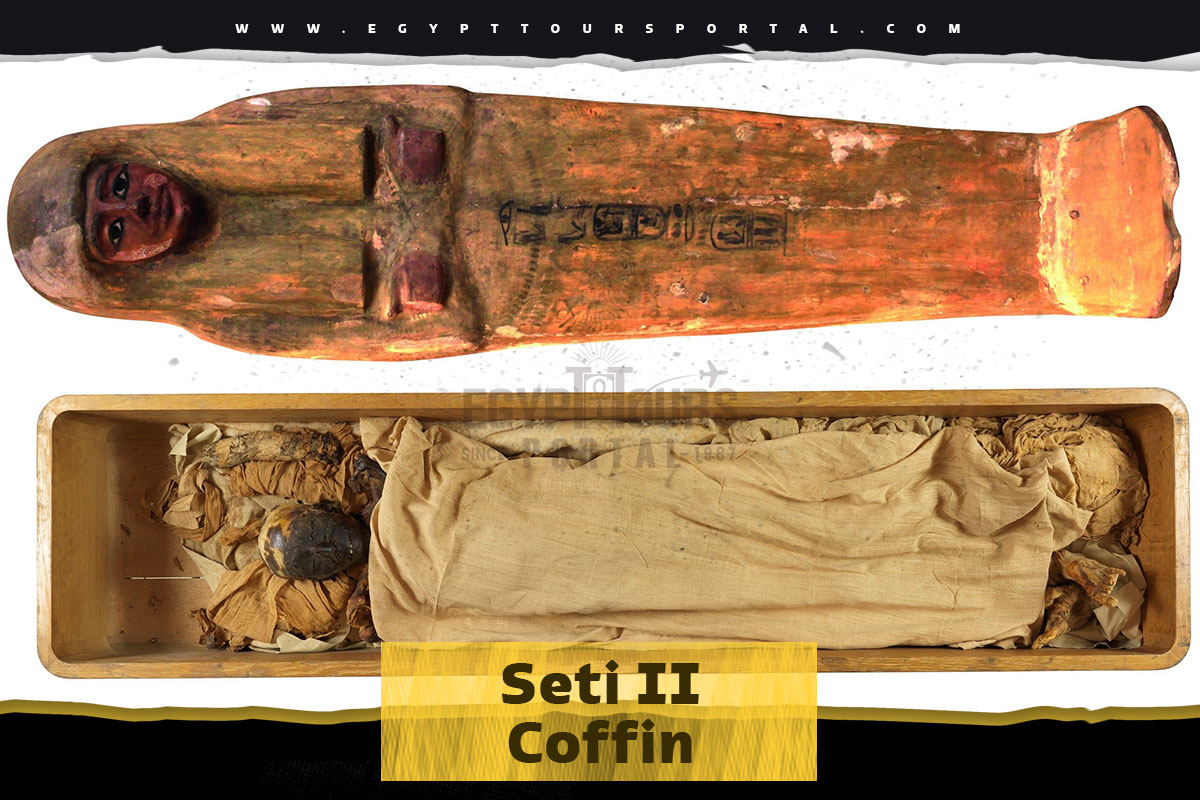
The coffin of Seti II (1203–1197 BC) is regarded as the smallest of all the coffins made among New Kingdom sarcophagi. this sarcophagus stands as a unique discovery. Adorning its upper surface is an Osirian depiction of King Seti II, while the reverse side features the outstretched figure of the goddess Nut.
Although the lid's crown and the visage of the King have been lost to time, the head of goddess Nut has found a new home within the Egyptian collection housed at the Louvre in Paris.
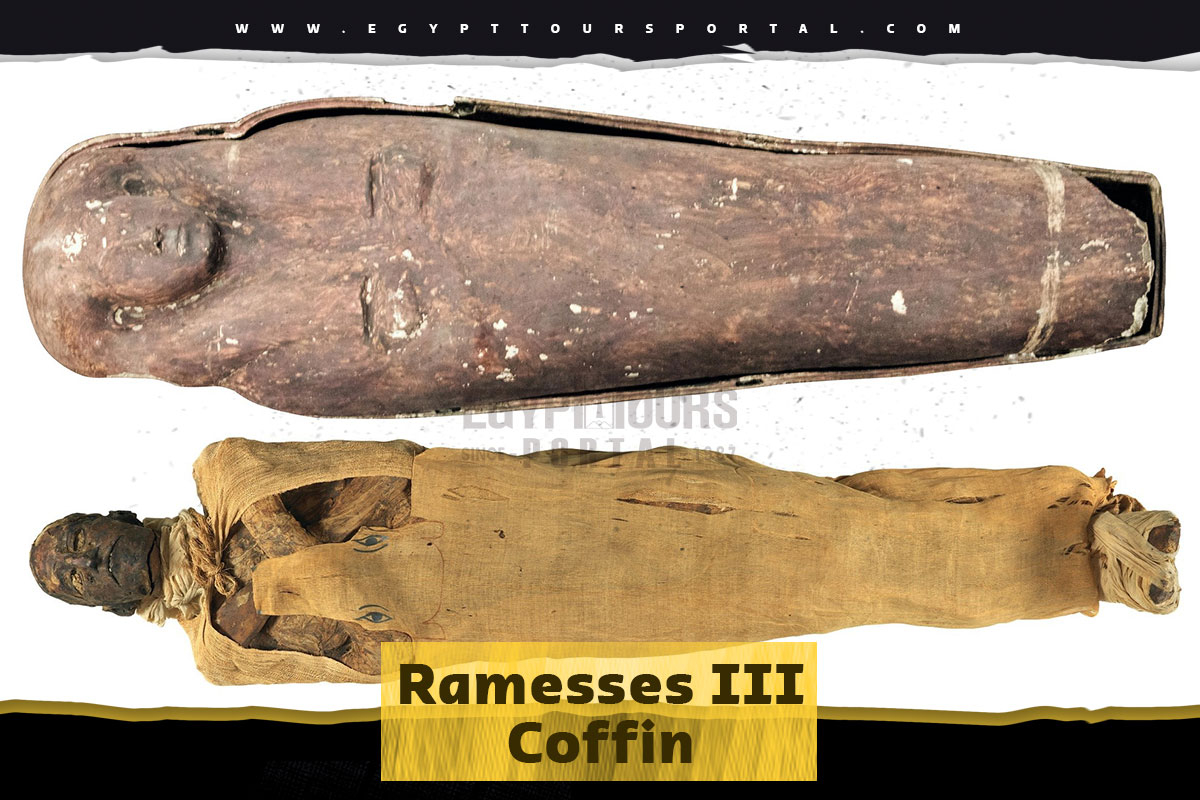
The tomb of Ramesses III (1186–1155 BC) comprises an eight-pillared hall that once held the red quartzite sarcophagus that was procured by General Henry Salt, the British Consul, and subsequently sold to the Louvre Museum in 1823. Everything started in 1815, The lid of the sarcophagus, featuring a raised relief figure of the King, was unearthed by Giovanni Belzoni and then sold to the Fitzwilliam Museum in Cambridge. The mummy of Ramses III was discovered within the KV 35 cache at Deir el Bahari in 1881.
The sarcophagus box is exhibited at the Louvre, while its lid has found residence at the Fitzwilliam Museum in Cambridge. This chamber is adorned with depictions from the Book of Gates, divine tableaus, and the Book of the Earth. Adjacent to this area lies a series of annexes adorned with the Book of Gates. The exterior of the sarcophagus is adorned with two scenes from the Amduat.
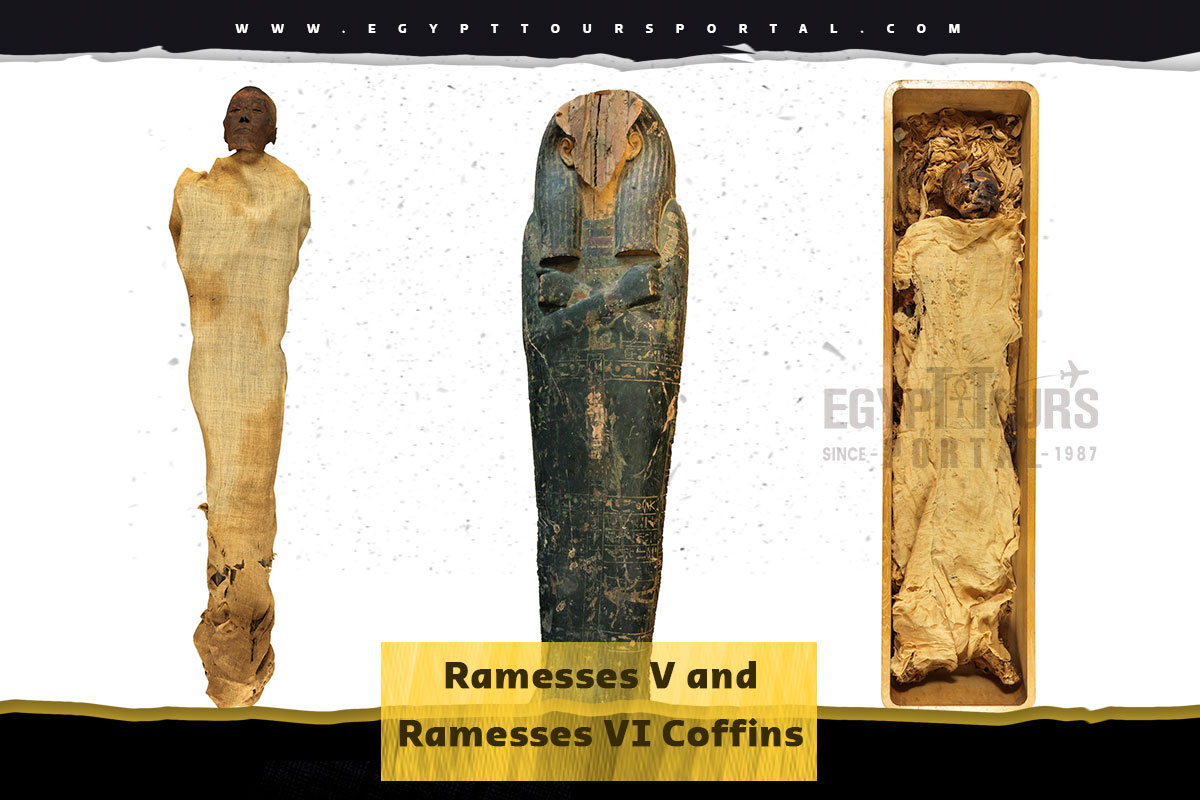
The mummiform stone sarcophagi of Ramesses V and VI were found in numerous fragments within a burial chamber. Substantial portions of Ramesses VI's lower sarcophagus sections still rest in his burial chamber, while the face is now housed in the British Museum.
These pharaohs' coffins were discovered shattered in an antiquity-damaged sarcophagus pit. The fragments from the kings' tombs and the Valley of the Kings were reconstructed in 2003 CE. The stone used is a sturdy green conglomerate sourced from Wadi Hammamat of the Eastern Desert.
Originally adorned with blue, yellow, red, and black paint, the sarcophagus bears ointment stains from burial rituals. Its carved decorations convey the king's afterlife journey, symbolically connecting him with the great sun god Ra and the ruler of the underworld Osiris. A replica of the original face on the lid has been located in the British Museum since 1823 CE. This sarcophagus was placed within an ever greater granite box, of which two large fragments remain in the burial chamber.
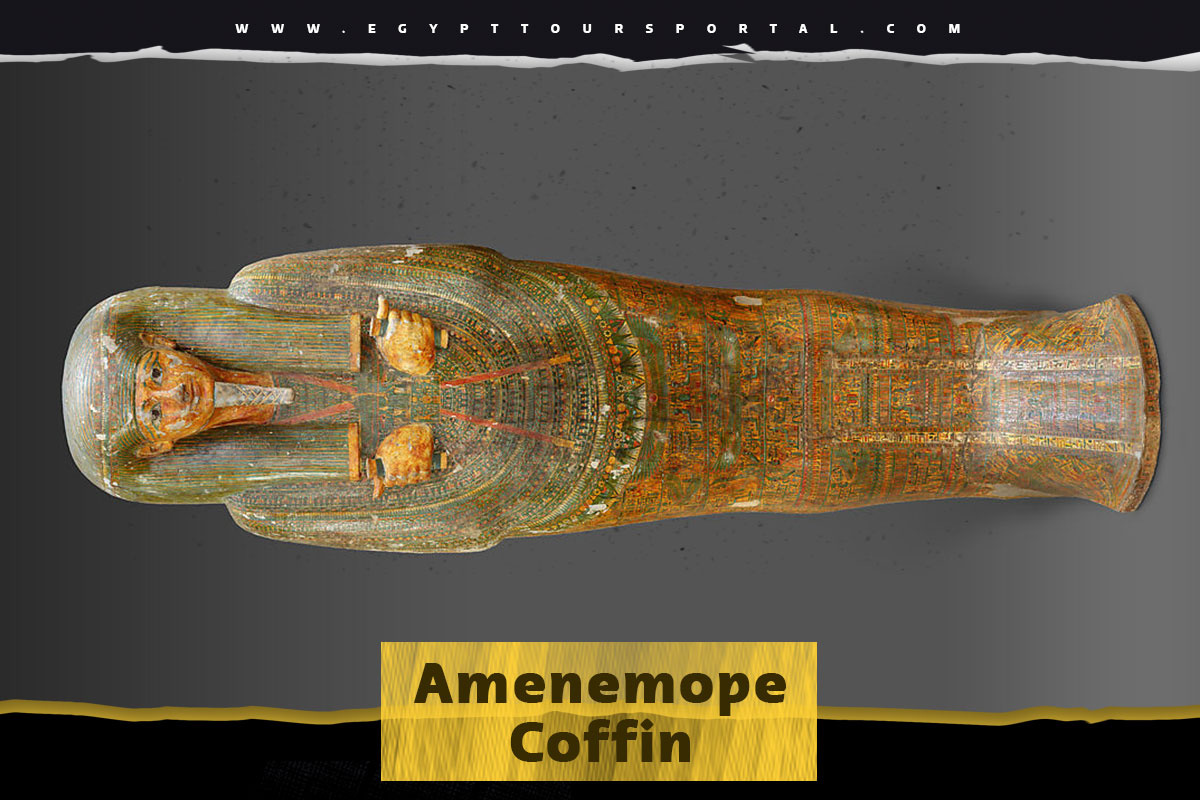
Amenemope held esteemed titles such as God's Father of Amun and Scribe of the Double Treasury. He belonged to a notable priestly lineage in Thebes with generations of family members holding similar roles. The two ancient Egyptian inner & outer coffins were sourced from Sheikh Abd el-Qurna which is found in Western Thebes. The outer and inner coffins share a similar design and adornment. Their lids showcase well-crafted faces with the characteristic deified beard, and their hands hold a makes, a royal document case. Both figures wear a distinctive red cloth around their necks called a stola, along with an oversized collar, highlighting a style typical of the period between 975 and 909 B.C.
Both lids are intricately decorated with miniature, polychrome scenes, primarily depicting adoration and presentation. The Gods are often raised in relief on the other hand the deceased is exhibited in painted lines. The inner surface of the outer coffin features epic religious and emblematic scenes centered on the deified Amenhotep I. Found On the inner coffin, the figures of the same pharaoh emerge, albeit partly obscured by embalming fluid stains.
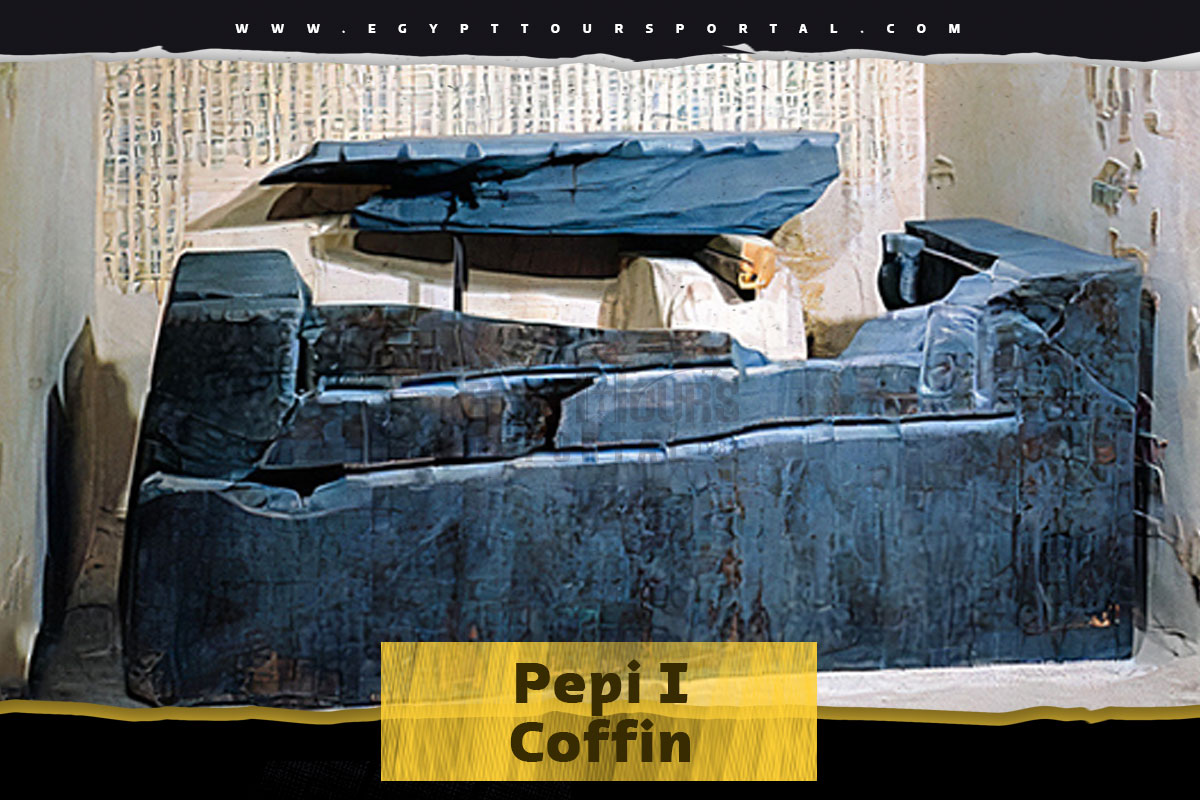
Within this tomb chamber, an intricately crafted canopic chest made of pink granite was discovered within his pyramid. Positioned within the floor, just in front of the sarcophagus of Pepi I, was the chest, while in close proximity, a compact bundle of internal organs believed to belong to Pepi I was found. The sarcophagus, hewn from a robust, dark stone, bore inscriptions including a line extracted from the Pyramid Texts. Notably, the sarcophagus was found devoid of its contents.
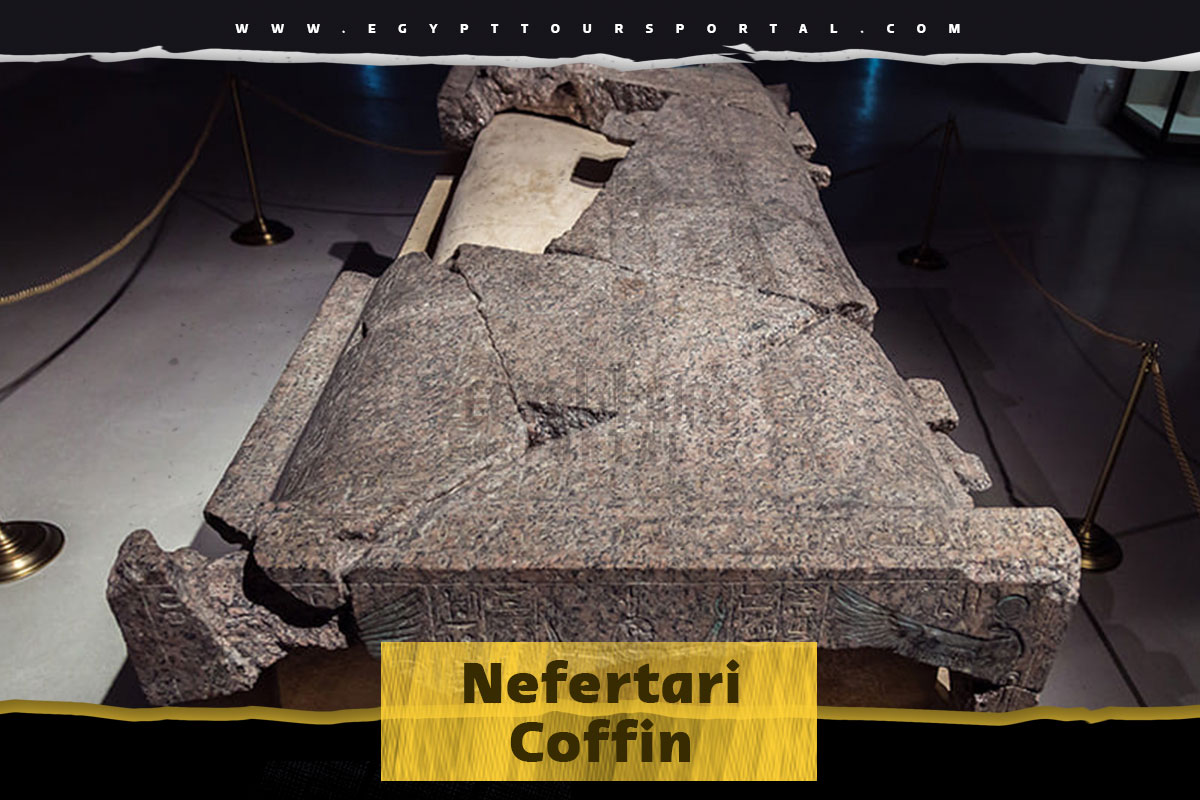
Nefertari, whose name translates to "Beautiful Companion, Beloved of Mut", held the cherished position of the Great Royal Wife (GRW) beside Ramesses II. Among the notable queens of Egypt such as Cleopatra, Nefertiti, and Hatshepsut, she stands prominently. Her tomb, designated as QV66, stands out as the most expansive, lavishly adorned, and breathtaking in the expanse of the Valley of the Queens. Positioned at the lower end of the main wadi on the north side, Nefertari's tomb (QV66) preserves its significance. Her tomb was unfortunately destroyed by tomb robbers, robbing away her beauty and funerary wealth.
The remnants of the reddish-pink granite lid, discovered by Schiaparelli, are now housed in the Turin Museum. The sarcophagus took on an oblong shape, a customary trait of 18th Dynasty royal sarcophagi. Its design seamlessly blended images with inscriptions arranged in both vertical and horizontal bands, mimicking the style of fastenings found on mummies. Towards the foot end, an image of Isis is flanked by Nekhbet and Wadjet, indicating that two crouching Anubis figures possibly adorned the head end beside Nephthys. On the upper part of the lid, aligned with her visage, the goddess Nut is distinguishable, her expansive wings spanning above the hieroglyphic representation of gold.
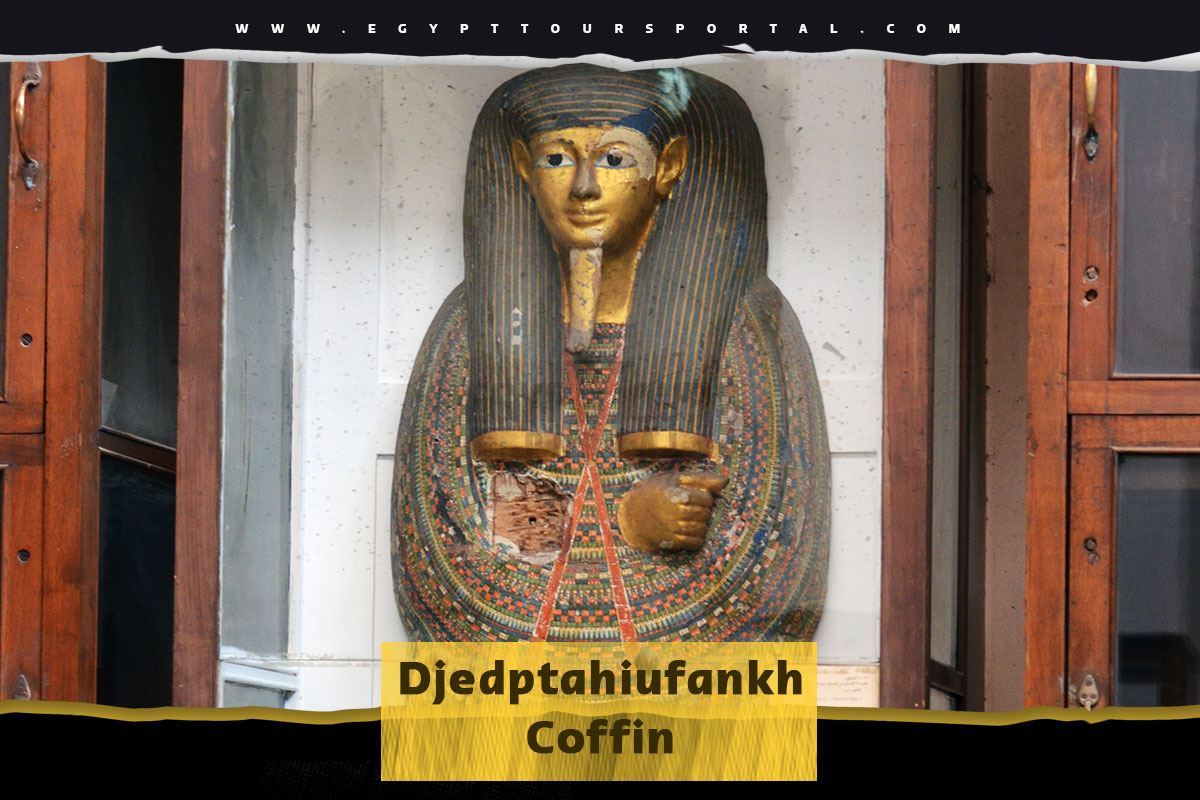
Ptahshepses' sarcophagus carries titles and decorations indicative of his high status and close relationship with King Unas. Its architecture and design reflect ancient Egyptian beliefs in protection, rebirth, and connection to the divine. The sarcophagus is dated to the fifth dynasty and showcases the intricate symbolic elements of ancient Egyptian burial practices. Ptahshepses' sarcophagus exhibited a distinct architectural design, characterized by a standalone rectangular structure placed within a burial chamber. This sarcophagus was oriented in a north-south direction, featuring protective wDAt-eyes on its exterior, symbolizing Horus' eye and guarding the body. The lid was equipped with protruding knobs for easy handling.
Believed to belong to the fifth dynasty, Ptahshepses' sarcophagus displayed elements like the lid's knobs and tomb construction attributed to King Unas. The presence of wDAt-eyes in the decoration suggests the involvement of the sixth dynasty. The primary intent behind this sarcophagus was to safeguard the mummy from theft, although it was ultimately looted from the eastern side. Decorative features on the sarcophagus chest encompassed a palace façade on the outer eastern side, while wDAt-eyes adorned the northern part of the eastern side. These wDAt-eyes served as Egyptian symbols of protection and connection to Osiris, signifying the deceased's transformative journey. Ptahshepses' sarcophagus found its place within a niche in the burial chamber, adhering to common burial practices.
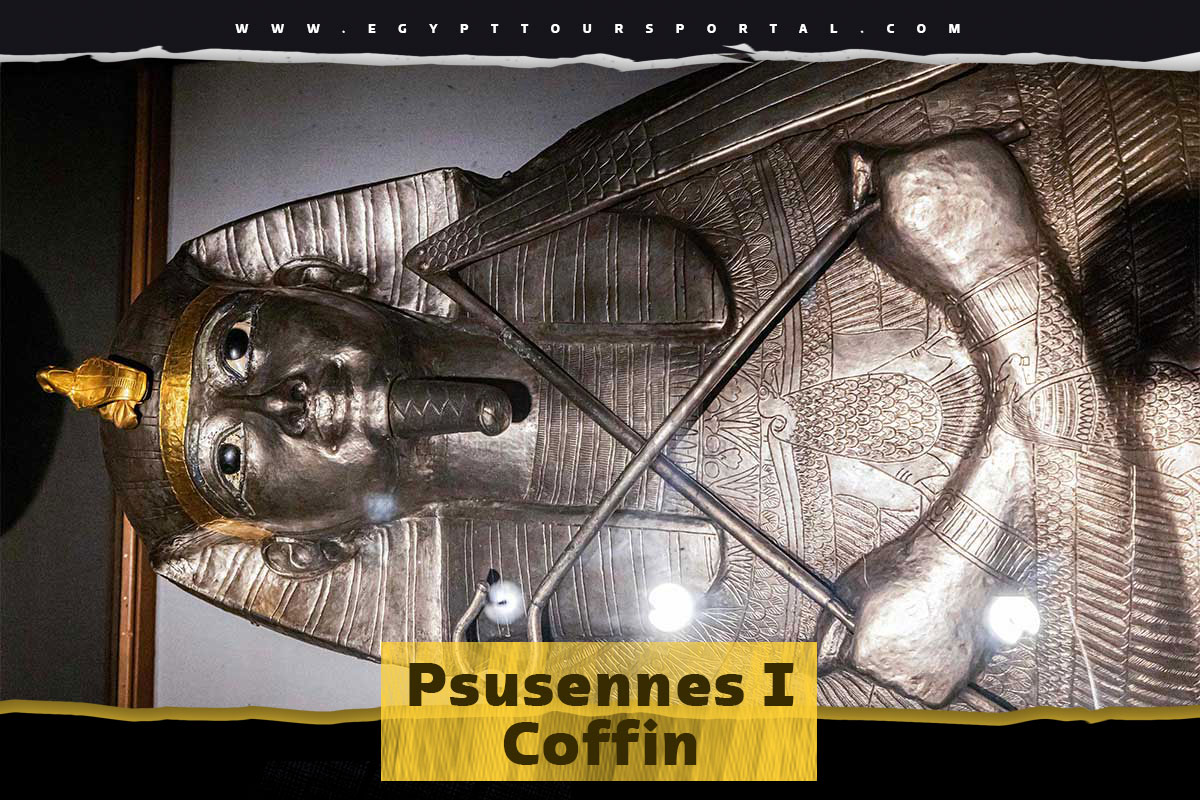
Psusennes I emerged as the third ruler of his dynasty during the turbulent Third Intermediate Period in Egypt. His reign marked a time of political strife, with the dynasty's power base in Tanis, an ancient city northeast of the Delta region. Psusennes I and his successor, Amenemope, found their final resting places in chambers beneath Tanis' Amun temple. Rediscovered by Pierre Montet in 1939, these burials offered remarkable insights into the era.
Amid a divided nation, the 21st Dynasty governed Lower Egypt from Tanis while the High Priest of Amun held sway in Thebes over Upper Egypt. The assumption that the 21st Dynasty pharaohs held limited authority was shattered by the discovery of Psusennes I's a tomb, notably featuring a solid silver coffin that earned him the title "Silver Pharaoh".
In ancient Egypt, gold symbolized the gods' flesh, while silver represented their bones. Psusennes' silver coffin underscored his extraordinary wealth, as silver had to be imported. The exquisite craftsmanship of items within the tomb, including the silver coffin, hinted at Psusennes' influence in mobilizing resources for luxurious creations.
Psusennes' silver anthropoid coffin nested within a pink granite coffin, enclosed by a granite sarcophagus. Remarkably, this sarcophagus once belonged to Merenptah, a 19th Dynasty pharaoh succeeding Ramesses II. The coffin lid showcased Psusennes I as a mummy, adorned with a golden uraeus for protection. A gold band adorned the forehead, while inlaid glass paste formed the eyes. Bird imagery with Shen signs of eternity adorned the chest, and long feathers covered the rest of the lid, accompanied by depictions of Isis and Nephthys at the feet level.
Though Psusennes' mummy had decayed, his tomb yielded a pile of bones, black dust, and various funerary items, including a gold mummy board and an exquisite solid gold mask for his face. This silver coffin, along with the gold mask and mask of Tutankhamun, stand as exceptional representations of ancient Egyptian craftsmanship and the esteemed status of the Silver Pharaoh.
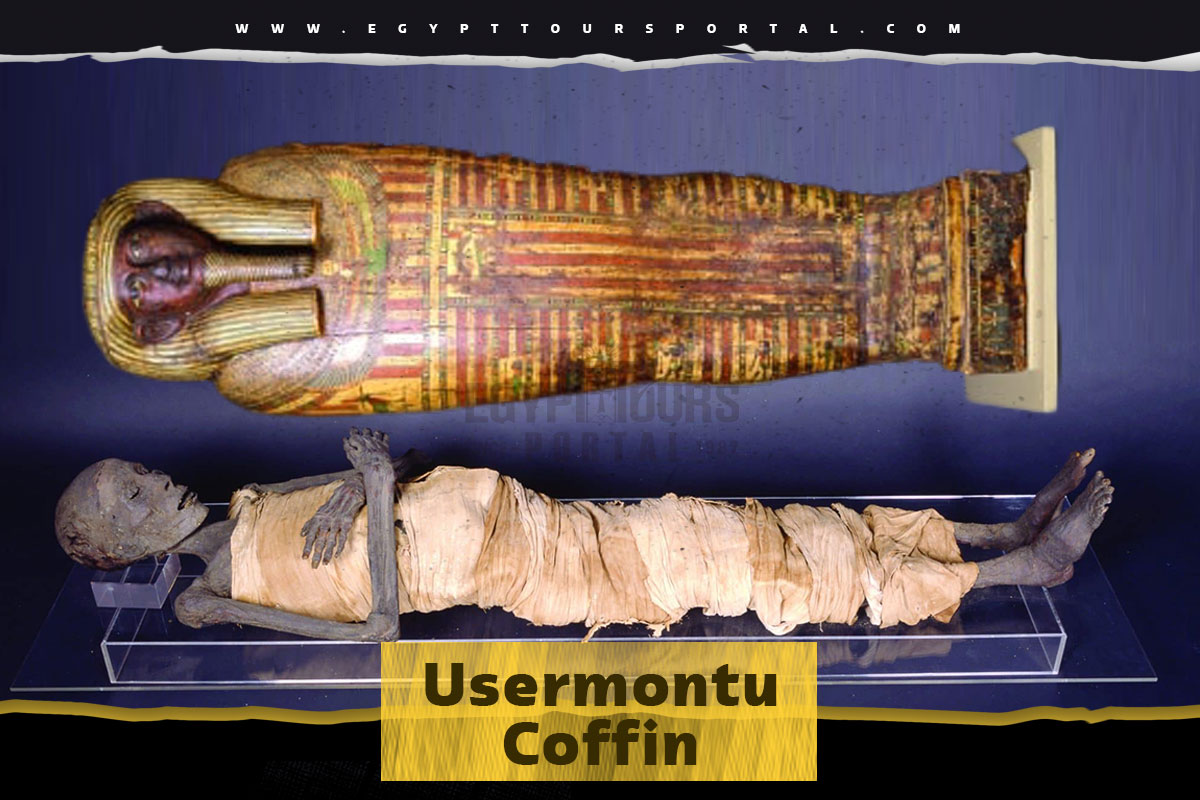
This marvelous anthropoid sarcophagus was owned by Usermontu, a prominent individual who served as the High Priest of Montu and Priest of the creator god Amun during the later years of Ramesses II's rule. It was discovered within his tomb located in the Theban necropolis. This marvelous pink granite sarcophagus is believed to have been placed within a larger black granite sarcophagus also found in the same tomb. Notably, stone sarcophagi were quite uncommon for the private people during the New Kingdom era.
The depiction of Usermontu on the sarcophagus showcases him adorned with a long, striated wig secured by a floral band, accompanied by the revered divine curved beard. Her is seen with his hands crossed holding a Djed pillar, symbolizing true stability associated with the rulers of the underworld Osiris, and an amulet that signifies protection and sacredness, linked to Osiris's sister-wife, Isis. Across his chest lies a broad festival collar. The exterior of the sarcophagus bears inscriptions featuring utterances from protective funerary gods depicted on the sides, including Anubis, Thoth, and the Four Sons of Horus. Within the sarcophagus, inscribed spells are intended to ensure the safety of Usermontu's body, invoking the protection of Nut, the sky goddess, whose full-length image is meticulously carved onto the box’s floor.
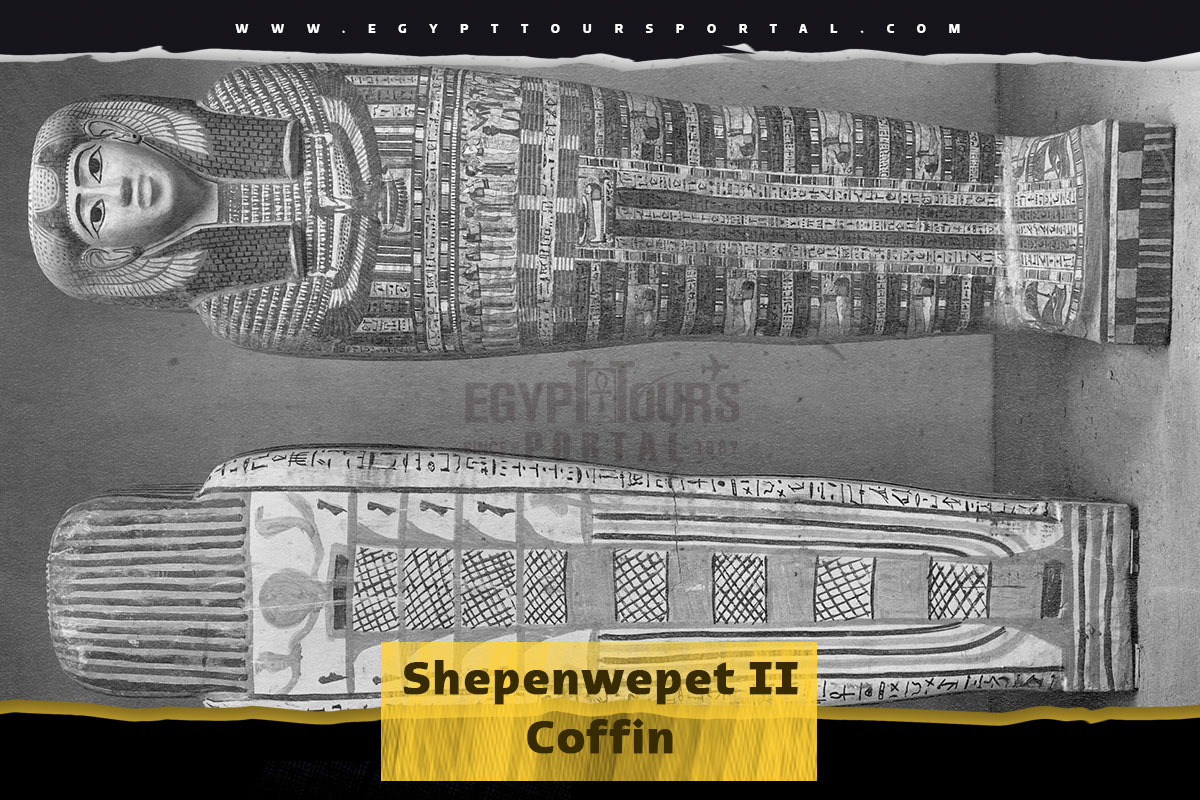
Ankhshepenwepet, known as the beautiful Singer of the Residence of Amun, found her resting place within a tomb situated in the incredible precinct of Hatshepsut's temple in the Deir el-Bahri. Unfortunately, her burial suffered from plundering, leaving no remnants of her mummy, which was positioned within the inner coffin.
The magnificent inner coffin of Ankhshepenwepet showcases a novel design that emerged during 25th Dynasty. It boasts a broader form with squared shoulders and a head of exaggerated proportions. Adorning her head is a lappet wig, its hair painted in a shade of blue, along with a majestic vulture headdress previously reserved for goddesses and queens. The lid's decoration includes a depiction of the heart-weighing scene from the Book of the Dead. Below this, a distinctive feature on coffins of that era, the mummy itself is illustrated.
It rests upon an embalmer's bed, while a ba-bird is seen symbolizing Ankhshepenwepet's spirit, hovering above the detailed photo. Under the bed, there are two groupings of items portrayed: four canopic jars and four bundles containing viscera which represent the internal organs. The depiction of the bundles suggests that the jars might be symbolic, serving as placeholders, resembling those found within Ankhshepenwepet's tomb.
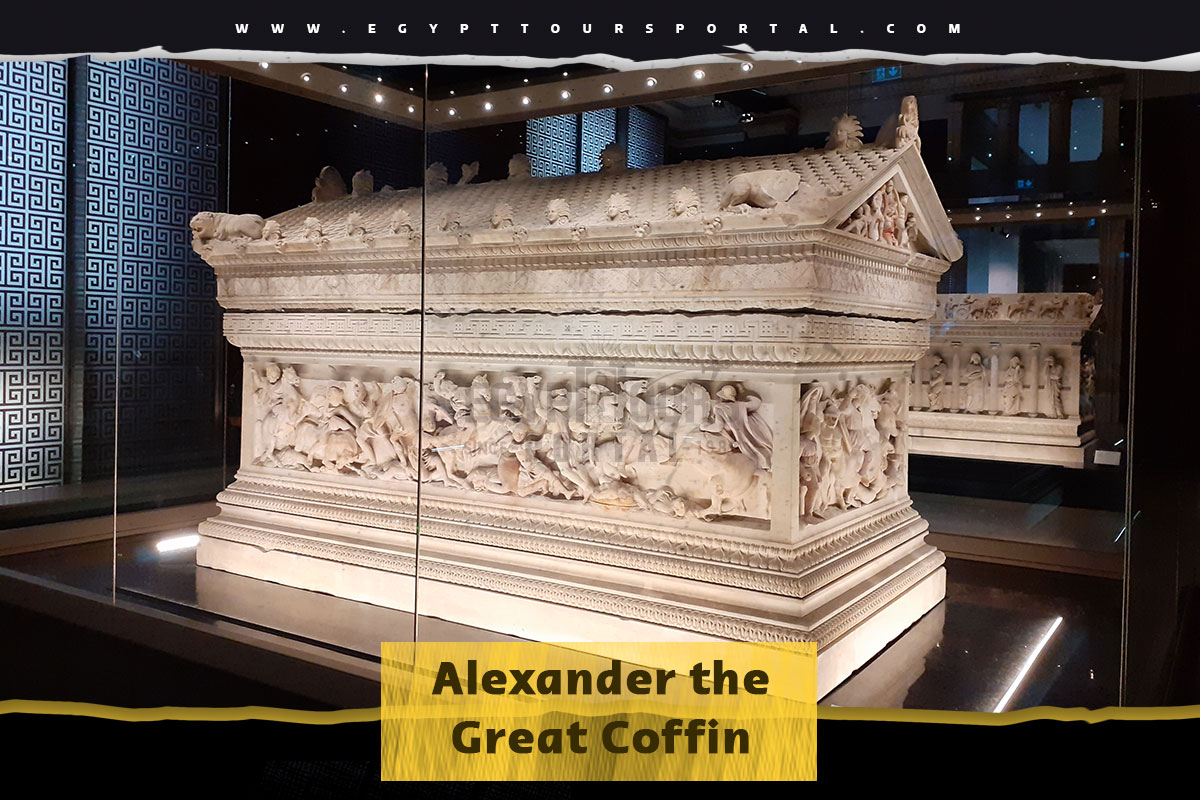
Numerous historical sources attest to the existence of Alexander the Great's tomb and Sarcophagus, yet its exact location remains a mystery. Initially interred in Memphis after his death in Babylon, his remains were later transferred to Alexandria by Ptolemy I Soter. Prominent figures like Julius Caesar, Cleopatra, and Augustus are known to have visited his tomb, but its fate remains uncertain, possibly lost or destroyed by the 4th or 5th centuries. Over a century of attempts have been made to locate it in Alexandria.
There are a number of coffins that belong to Alexander the Great such as the Alexander Sarcophagus which is a Hellenistic stone sarcophagus from the Sidon necropolis in Lebanon, and features bas-relief carvings depicting Alexander the Great and historical narratives. It is remarkably preserved, showcasing its polychromatic details. Scholars generally agree on its origin in Sidon and its commissioning after 332 BC. The depiction of Abdalonymus, the King of Sidon, helps date its creation to before his death around 311 BC. The sarcophagus was discovered in a necropolis during excavations in 1887, providing insight into its historical context.
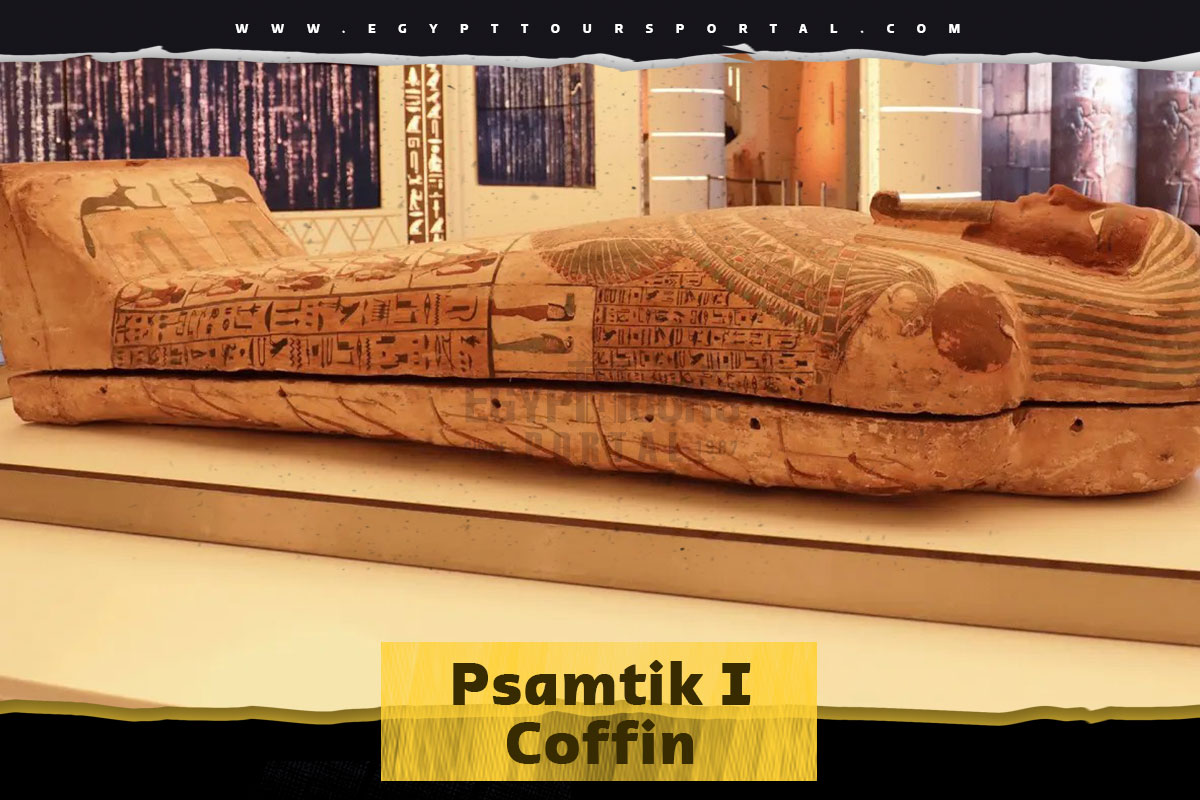
Psamtik (664–610 BC) an overseer of Libyan mercenaries and chief physician, constructed a splendid tomb in the form of a room-sized underground sarcophagus. The sarcophagus lid, made of basalt, measures around 2.46 meters in length and weighs approximately 3 tons. Despite his wealth and proximity to the king, Psamtik was never interred in the tomb, and the lid remained above the basin, awaiting his burial.
The anthropoid-shaped lid features a broad, squared face, large ears, and a smooth, unarticulated body with slightly protruding feet. Inscriptions on the lid consist of fragments of spells from various ancient texts, such as the Pyramid Texts, Coffin Texts, and Book of the Dead. Speeches of gods advocating for the deceased are also present. Psamtik's coffin was adorned with a falcon-headed amulet showcasing the goddess Nut with outspread wings holding feathers of justice from the goddess Maat. The center of the sarcophagus holds incantations, flanked by 'Was' deities with scepters. At the bottom, symbols of Anubis, the jackal-headed god of the dead, are depicted, welcoming the deceased into the afterlife.
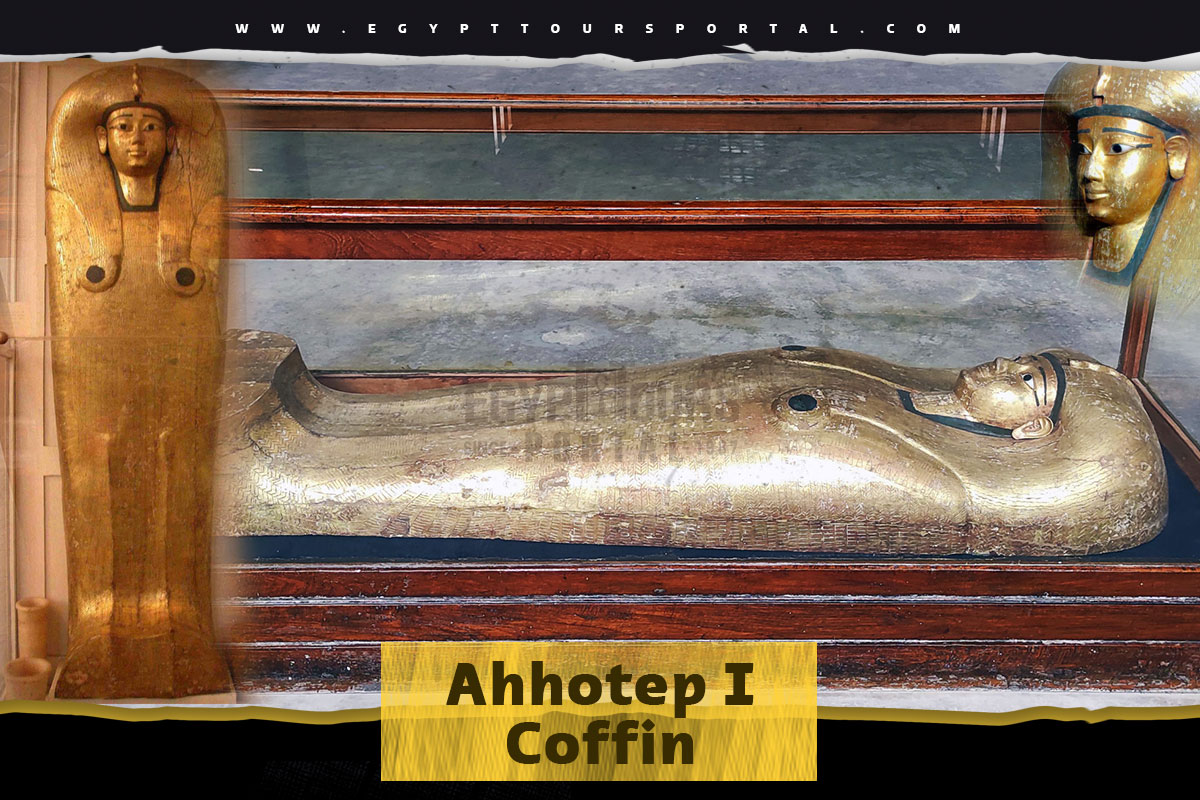
Ahhotep Tanodjmu's coffin was discovered in the offering hall of tomb CC 37 in Lower Asasif, along with thirteen other coffins. Dating back to early Dynasty 18, the coffin exhibits a simple design with a white background. The depiction of the deceased features a long-striated wig and a broad festival collar. Notably, the lid's primary decoration highlights the elongated figure of the sky goddess Nut, symbolically offering protection.
Inscriptions running horizontally from the lid to the sides invoke funerary deities, who are portrayed between these bands on the box's sides. Within the coffin, a woman's mummy was found positioned with her right arm over her chest and her left arm at her side. When her shroud was lifted, two figures were revealed. Among her belongings was a small round basket containing a heart scarab on her legs, while two scarabs were tied to her left hand—one with the name of the Herald, Reniseneb, and the other featuring a winged Kheper beetle with a sun disk. Beneath her body was another small basket containing three copper forceps and a kohl stick.
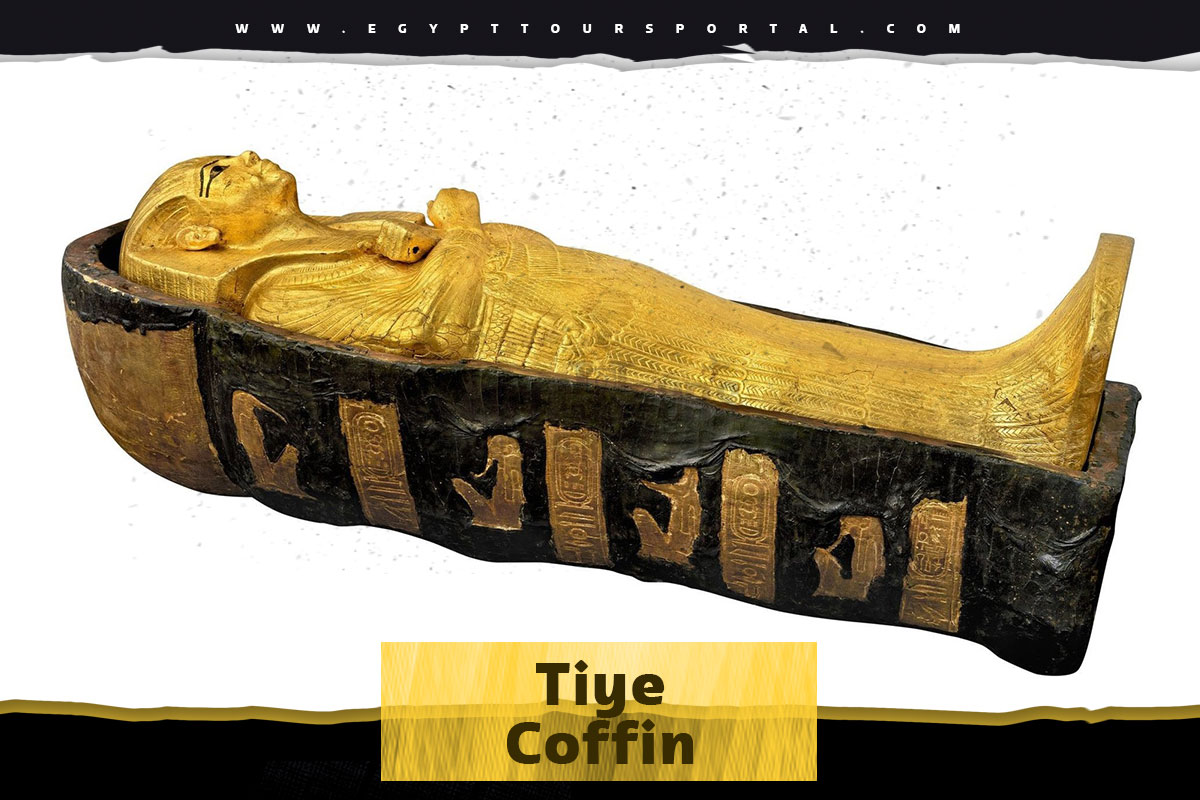
Queen Tiye (1398 BC – 1338 BC) was the Great Royal Wife of the Egyptian pharaoh Amenhotep III, mother of pharaoh Akhenaten and grandmother of pharaoh Tutankhamun. The coffin discovered in KV55 in the Valley of the Kings was originally intended for a female during the Amarna Period and was later adapted for the burial of a male member of the royal family. The inscription alterations on the lid and trough reveal this transformation. There's an ongoing debate about its intended occupant, with earlier theories mentioning Queen Tiye, Meryetaten, Akhenaten, and Nefertiti, but modern consensus leans towards it being crafted for Kiya, Akhenaten's secondary wife. The shifting remains within KV55 complicate identification, and previous beliefs that the skeleton belonged to Queen Tiye were debunked by later examinations revealing a young male.
The figure on the coffin lid represents a mummified shape with an exposed head and hands. The person wears a Nubian-style wig associated with Queen Kiya, adorned with a gilded bronze uraeus bearing the Aten's names. The face features remnants of a gold-sheet mask, once inlaid with blue glass and semi-precious stones for the eyes. A false beard of blue glass with gilding curves beneath the chin. The individual adorns a broad Wesekh collar with intricate feathers and plant inlays. The crossed arms once held the crook and flail royal insignia, with thongs of the flail preserved beside the coffin. The mummiform figure is embellished with a rishi design, a royal prerogative for coffin decoration, showing overlapping naturalistic feathers over the chest and upper torso, and stylized feathers over the lower torso and legs. The KV55 coffin shares similarities with Tutankhamun's middle coffin, both adorned with gilded surfaces and colorful glass and stone inlays in a rishi design.
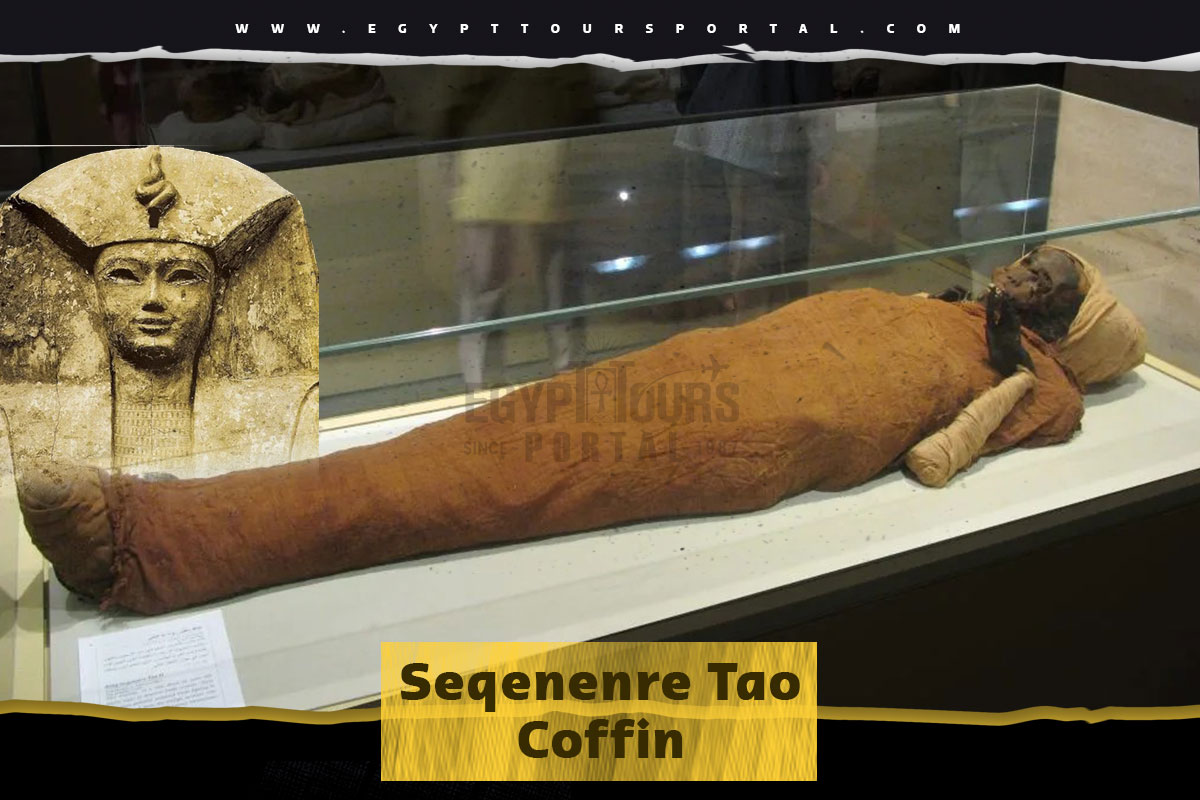
The priests of Amun lay Seqenenre's anthropoid coffin in a roughly cut rock tomb at Deir el-Bahri, where it joins his later New Kingdom successors due to depleted royal tombs at the Valley of the Kings. His tomb at Dra Abu el-Naga, below Theban hills, has also been plundered, and his modest belongings recycled. The priests remove valuable items from his body, including amulets and jewelry, possibly explaining his horrified expression.
They also scrape off the coffin's gilding but leave Ptah-Sokar's name and the king's uraeus untouched, repainting certain areas. Lost inscriptions are rewritten, and gesso covers areas devoid of gold. Despite this, some respect is shown. Once sealed in his new tomb, Seqenenre rests in eternal slumber.
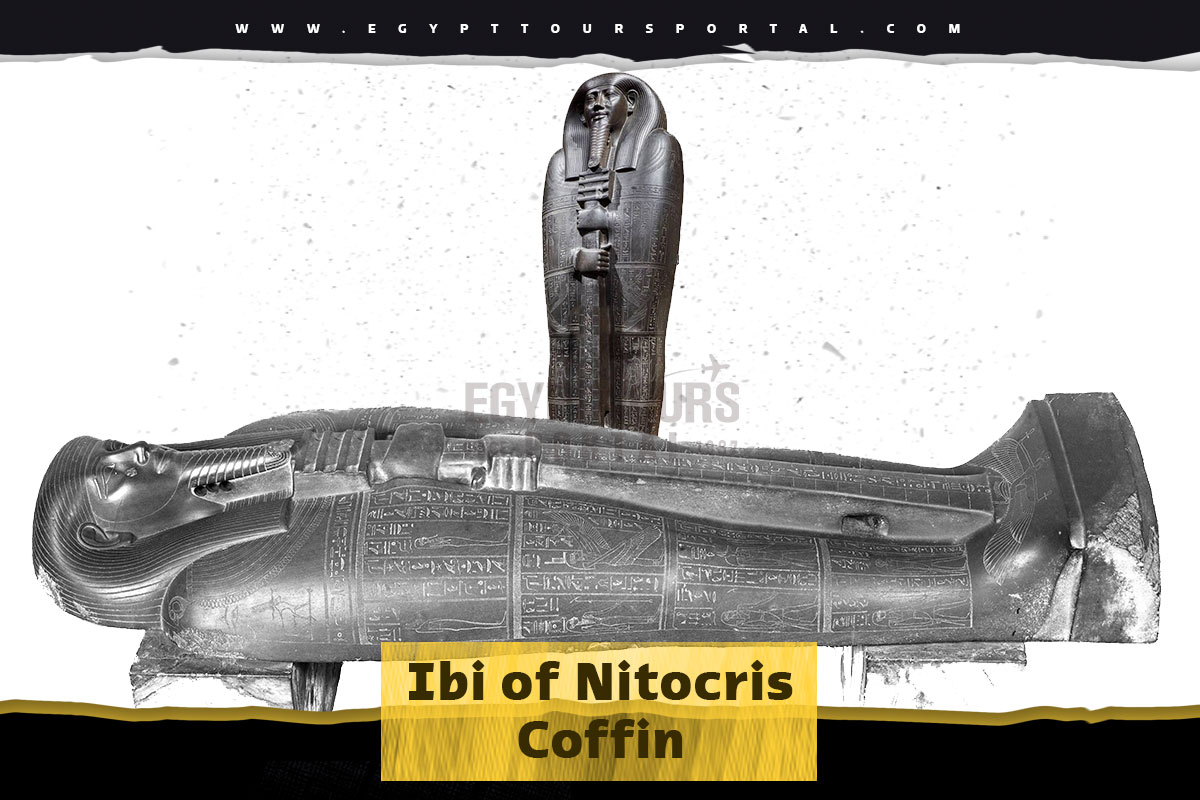
The finely sculpted sarcophagus of Ibi, Chief Steward of Nitocris, Divine Adoratrice of Amon, reflects his high status. Ibi managed the estate of Nitocris, a prominent religious authority in Thebes. The lid portrays Ibi as Osiris, his hands reaching from the shroud to hold the Djed-pillar, symbolizing his resurrection.
Depicted deities on the body's incised mummy bandages aid Ibi's journey in the afterlife. The sky-goddess Nut appears on his feet with outstretched wings, holding an ankh symbol for his daily rebirth like the rising sun. Holes underneath the beard and scepter were likely for easier handling of the heavy sarcophagus, weighing over a ton.
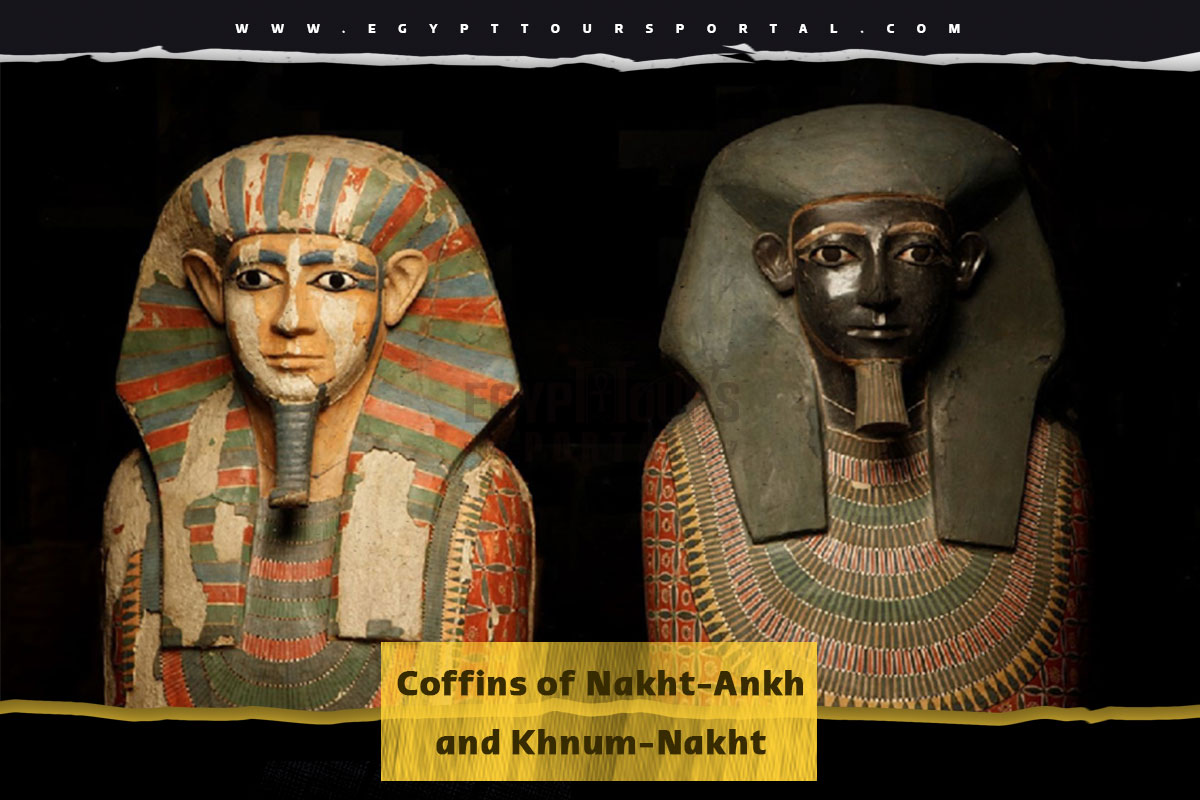
The outer rectangular coffin of Nakht-Ankh features text columns on the lid and sides, including an offering formula to Anubis for safe passage and ascension to the gods. Another spell hopes for Nakht-Ankh's place in the boat of the sun god across the heavens. The coffin's texts aim to secure his divine afterlife status. The coffin box contains various spells, with some belonging to the Coffin Texts corpus. The exterior of Khnumnakht's coffin showcases intricate artwork, featuring a variety of texts and decorative panels, a common trait of late Middle Kingdom coffin ornamentation. Notably, the figure of the goddess on the head end is unusual for periods preceding the late Middle Kingdom.
The details, including figures and hieroglyphs, are meticulously drawn by a skilled artist, adhering to the artistic conventions of that time and place. The left side of the coffin box presents an architectural facade with a small doorway, reminiscent of the Old Kingdom false door. This symbolic feature allowed the spirit of the deceased to transition between the realms of the living and the dead. The depiction imitates two wooden door leaves held together by bolts. Positioned above the door are two eyes gazing into the realm of the living, and behind this panel would be the mummy's face. The remainder of the exterior is adorned with invocations and recitations by various primeval deities, especially those linked to death and rebirth, such as Osiris and Anubis.
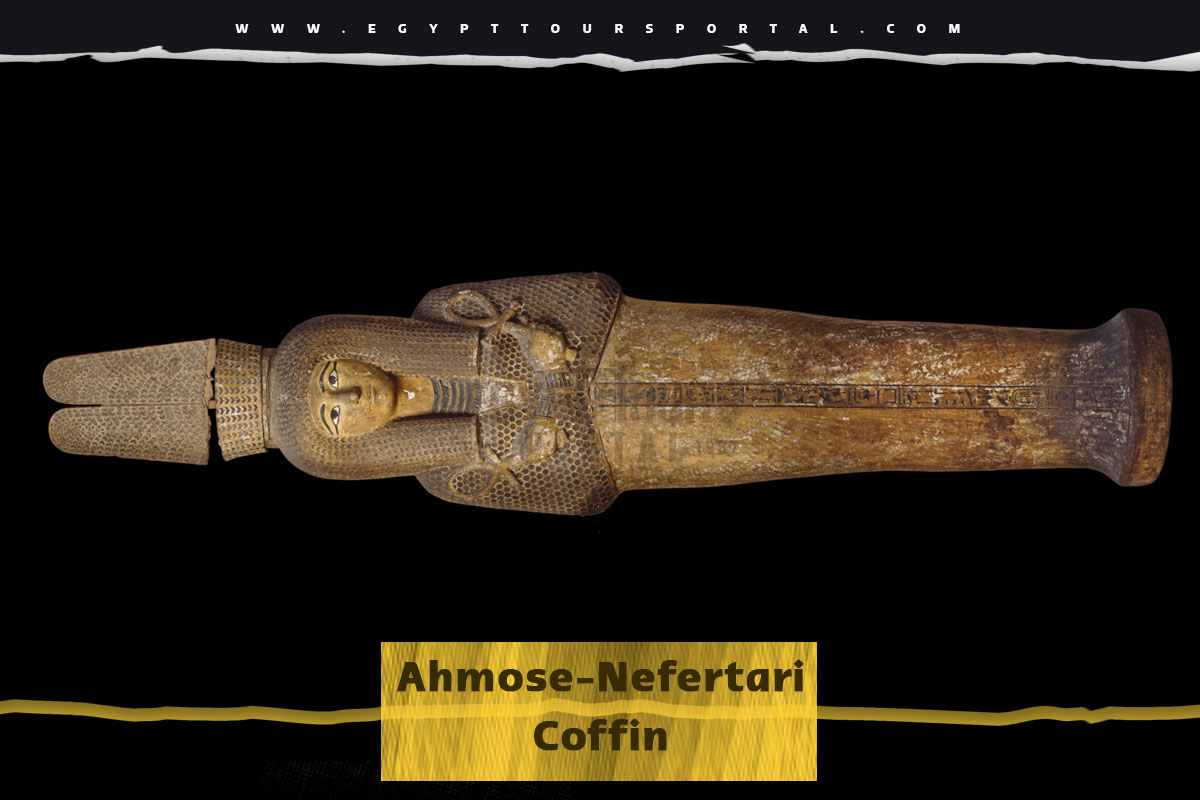
Ahmose-Nefertari's Coffin is a glimpse into the Past which was inflicted by tomb raiders were apparent. Nevertheless, her mummy managed to retain a reasonable state of preservation, revealing that she enjoyed a lengthy life, reaching the impressive age of 70. She encased her mummy was a grand wooden coffin, a prevalent style among the early 18th Dynasty queens' burial practices.
Regrettably, any gilded adornments or precious gemstones that once adorned the coffin had fallen victim to theft by tomb looters. It is noteworthy that within this coffin, not only did Ahmose-Nefertari's remains rest, but it also contained the coffin and mummy of Ramesses III, a unique juxtaposition of regal afterlife companions.
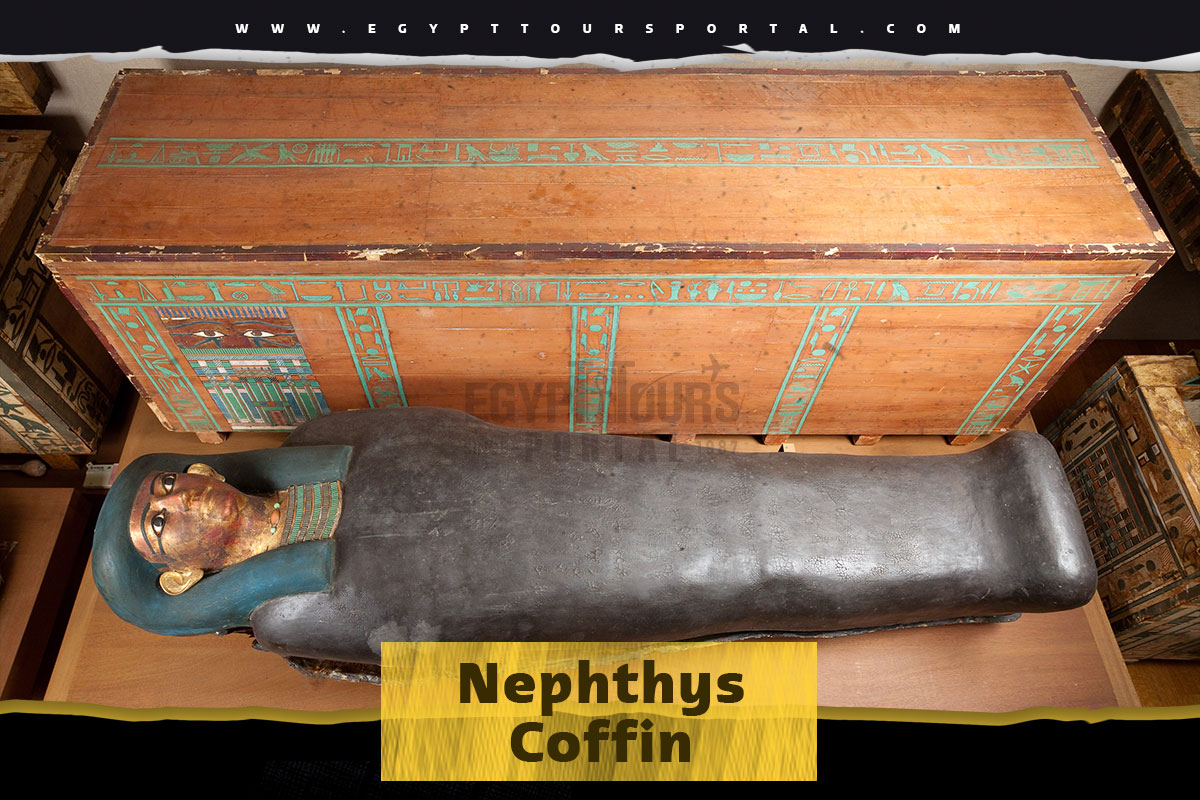
Within the untouched burial chamber of a pit nestled within the tomb of Senbi II in Meir that dates between 1961–1878 B.C. It is a fascinating discovery made of a pair of coffins, each holding its own unique significance. The outer coffin, rectangular in shape, bore inscriptions revealing its original owner to be Ukkhotep. However, intriguingly, these inscriptions had been altered to accommodate Nephthys, a "Member of the Elite" and the daughter of Ukkhotep.
The outer coffin is adorned with a decorative arrangement, including a palace facade eye panel and bands of inscriptions. These inscriptions contain funerary formulae that highlight the reverence bestowed upon the deceased by various deities. found within the inner anthropoid coffin, the mummy lay preserved. This coffin features a gilded face and a faience broad collar, adding an exquisite touch to the solemnity of the burial. Together, these coffins offer a glimpse into the rituals and artistry of ancient burial practices.
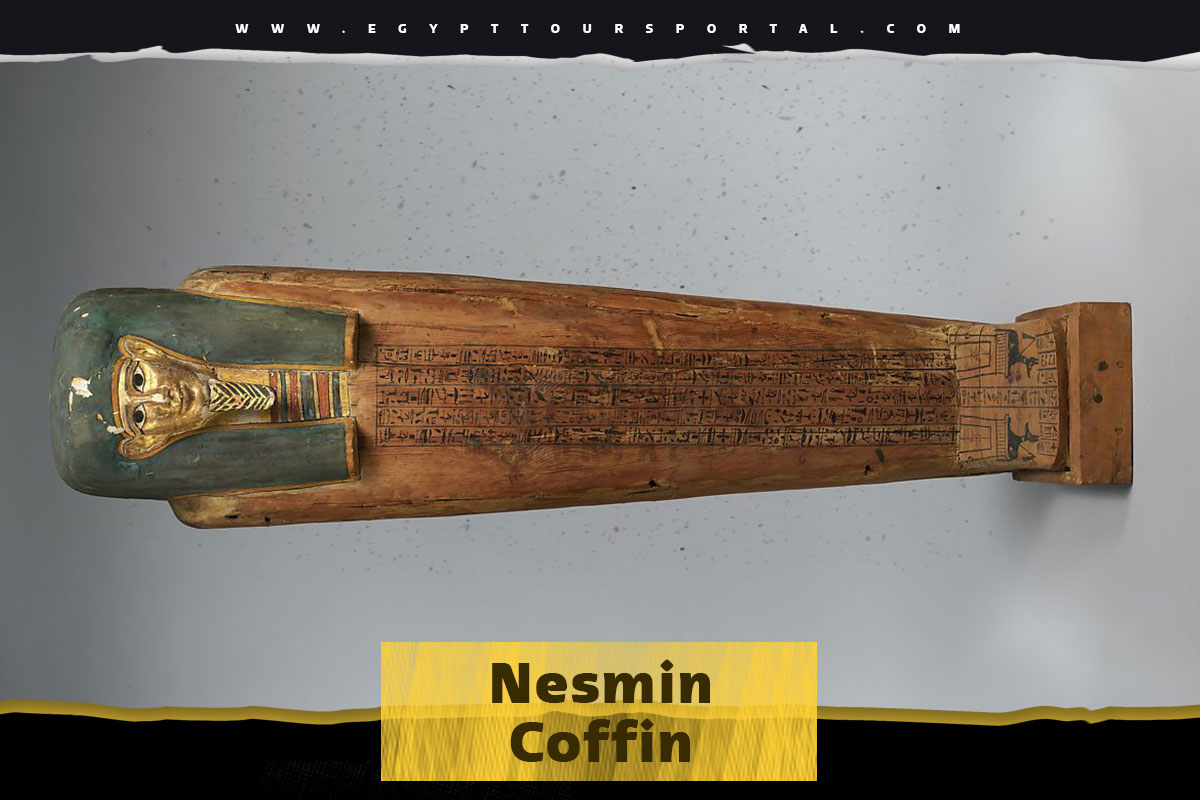
Nesmin, son of Ankh-hap, devoted priest of the deity Min in Akhmim in the Ptolemaic period between 200 and 30 BC. Inscriptions on the coffin provide not only Nesmin's identity but also the names of his parents. Djedhor, his father, carried the honorable title of priest, while his mother, Tadiaset, contributed her musical talents to the service of Min. It shows that He finds his eternal abode within this intricately adorned coffin Shaped in the likeness of the mummy it cradles, the coffin boasts a gilded visage that reflects the significance of the journey to the beyond.
The artistry showcases incised and gilded designs, with inscriptions that grace the lid's lower edges. On the right-hand side, these inscriptions honor a multitude of deities who play roles in the passage to the realm of Osiris, chief of the West. Among them are Anubis, the guardian of the afterlife, and Isis, the divine protector. The invocation extends to Min, Imseti, Hapy, Duamutef, and Kebehsenuf - the revered 'Four Sons of Horus.
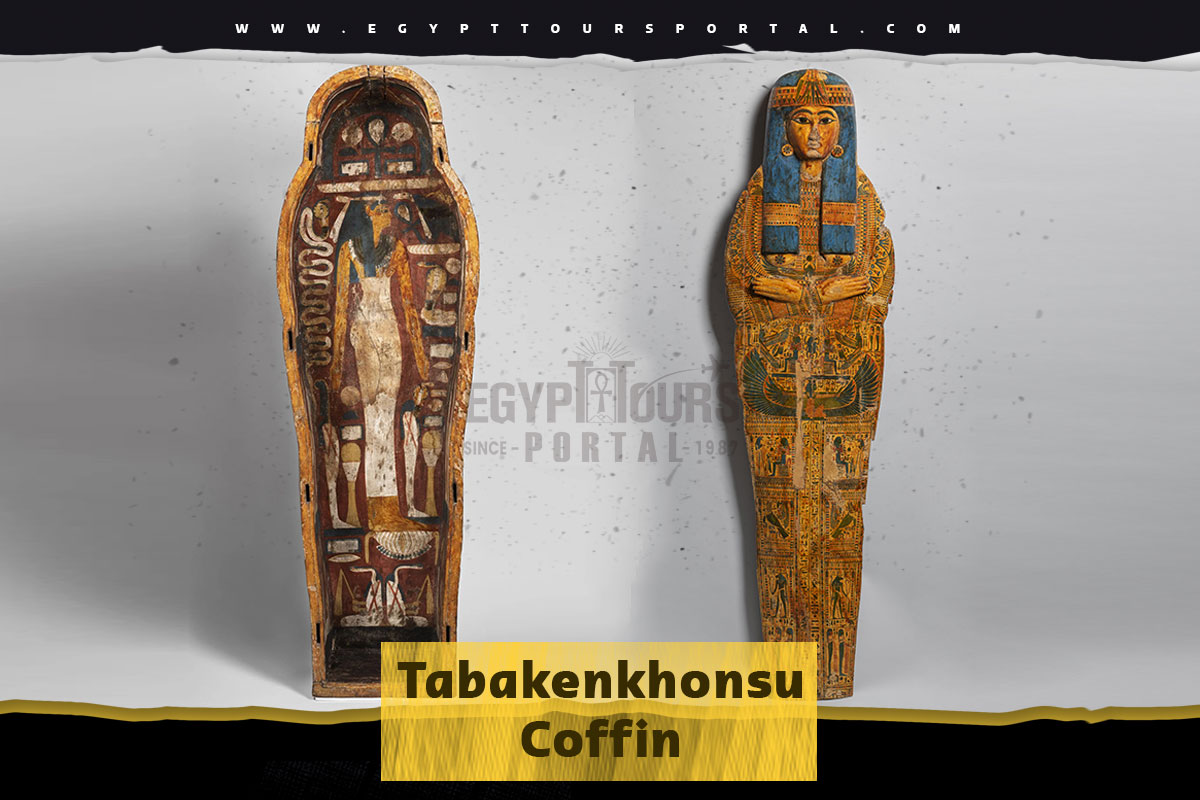
In the Temple of Hatshepsut found at Deir el-Bahri dating to 680–670 B.C. in the Kushite dynasty, a sealed chamber was discovered containing wooden coffins holding the mummy of Tabakenkhonsu, a Mistress of the House. She belonged to a lineage of Priests of Montu and lived around 800 years after the temple's construction. The temple was used by various priestly families for tombs during that time.
The coffins of Tabakenkhonsu whom another Priest of Montu named Djeddjehutyiufankh who could be her husband, and her possible mother-in-law Nesmutaatneru were found completely undisturbed, adorned with dried funeral wreaths. The outer coffin had a vaulted lid and depicted divinities guarding the god's body. The two inner anthropoid coffins represented Tabakenkhonsu in her divine form, with the larger one being relatively plain, while the innermost was covered with marvelous religious texts and epic illustrations for her journey to the afterlife.
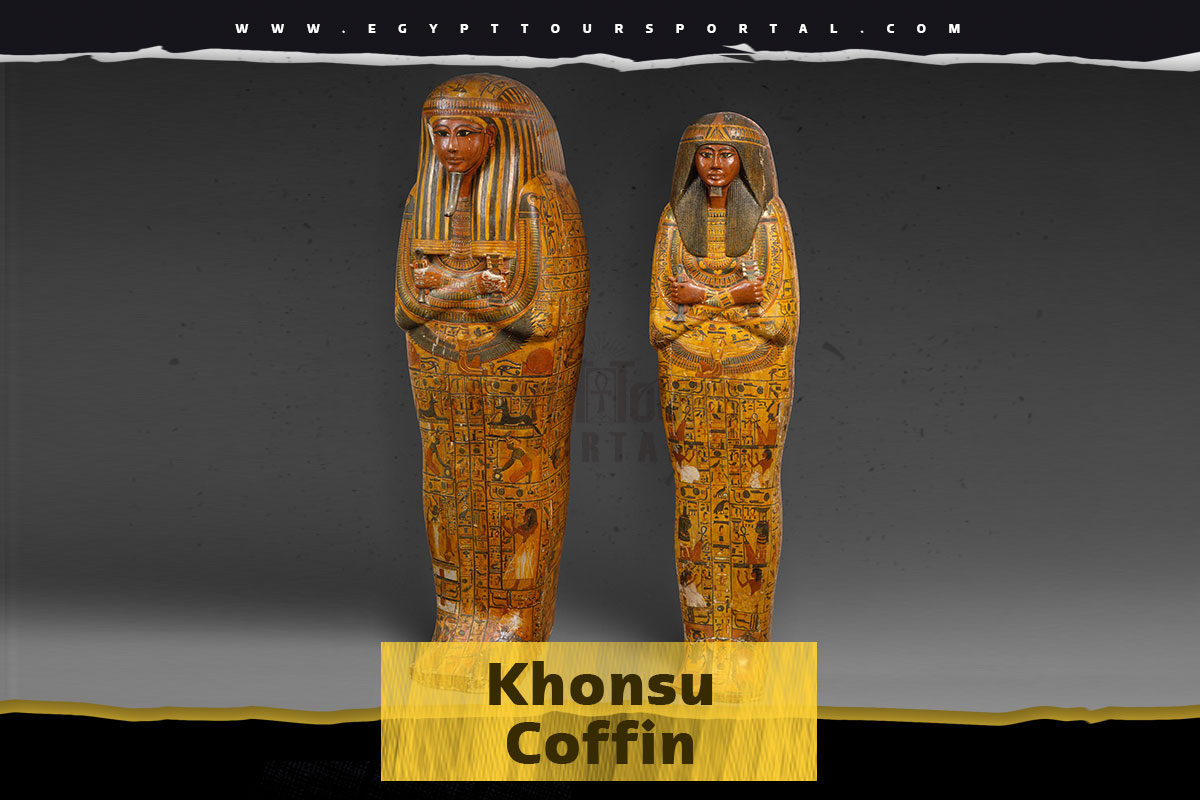
Khonsu was a Servitor at the Place of Truth during the reign of Ramses the Great between 1279–1213 B.C. and was buried in his father Sennedjem and mother Iineferty's tomb. His mummy, concealed by a mummy mask, rested in a wooden inner coffin. He appeared to be aged between fifty and sixty, as indicated by the coffin.
Khonsu's coffin depicted him with a tripartite wig, holding symbols of stability and protection. The inner coffin displayed him in a double wig and goatee, alongside his wife, kneeling before gods Osiris, Anubis, Isis, and Nephthys, with magical spells adorning the decorations.
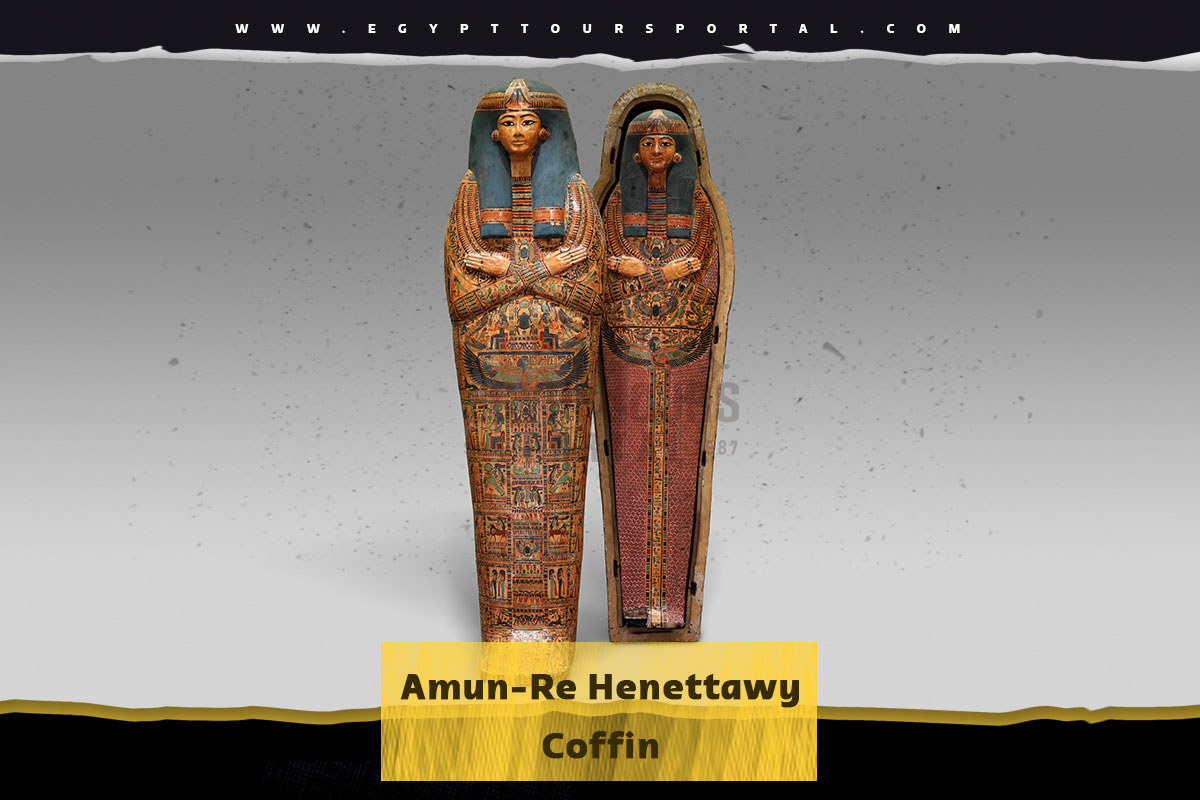
Henettawy was a young "Mistress of the House" and singer of Amun-Re between 1000–945 B.C. and passed away at twenty-one. Her tomb, once belonging to Minmose, was modest and had been looted. She was buried without embalming, wrapped in linen bandages. Her burial items included two exquisite coffins and a mummy board that nested like Russian dolls.
The outer coffin bore an ornate pectoral with winged Wedjat eyes, uraeus cobras, and falcons, symbolizing rebirth. Anubis figures adorned the sides. Beneath Nut's protective wings, golden bands adorned the white mummy wrapping, inscribed with prayers. Scenes depicted Henettawy with a sistrum praying to Osiris, offerings to the sons of Horus, and Anubis holding scepters. Isis and Nephthys mourned at her feet.
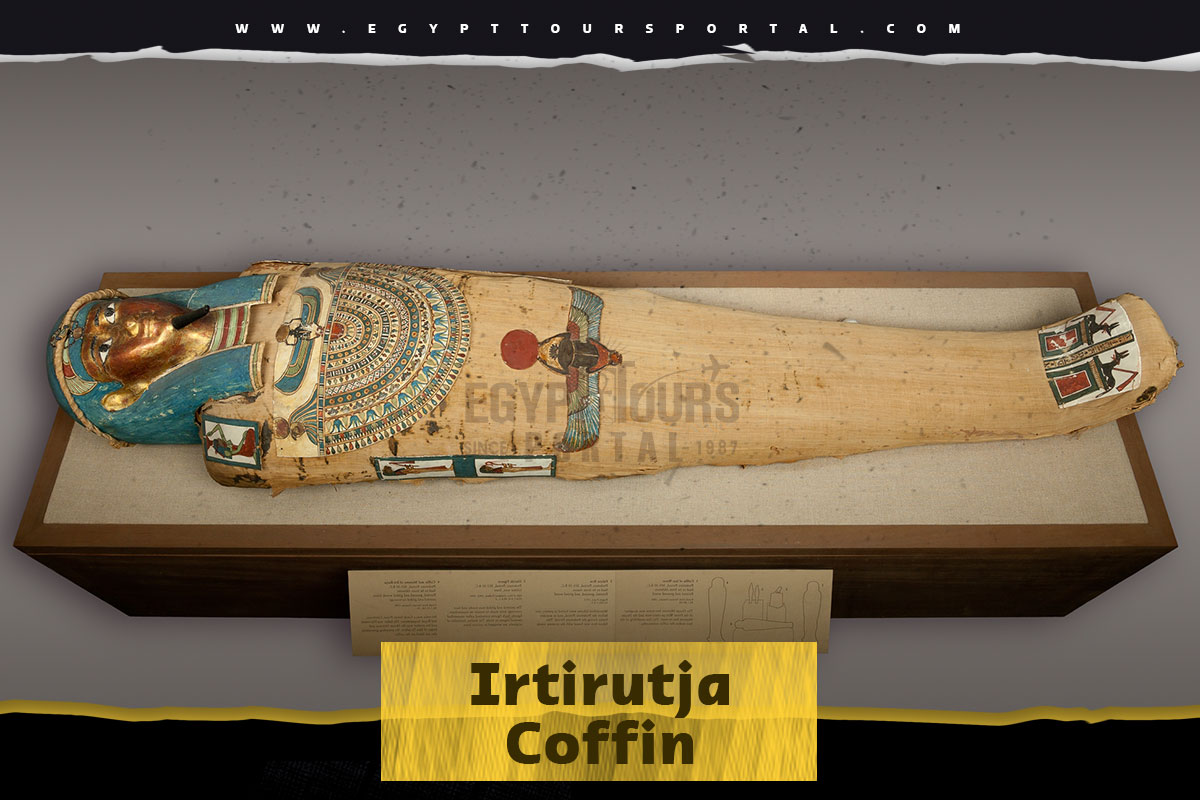
Irtirutja held the position of priest in Akhmim between 332 and 250 B.C., and the coffin's inscription traces his lineage through seven prior generations, highlighting his father Harresnet and his mother Taneferti, who served as a musician for the deity Min. The coffin's ornate design features a winged scarab beetle situated at the head, a wide collar with falcon motifs on the chest, depictions of various deities in the central area, and representations of the god Anubis adorning the feet.
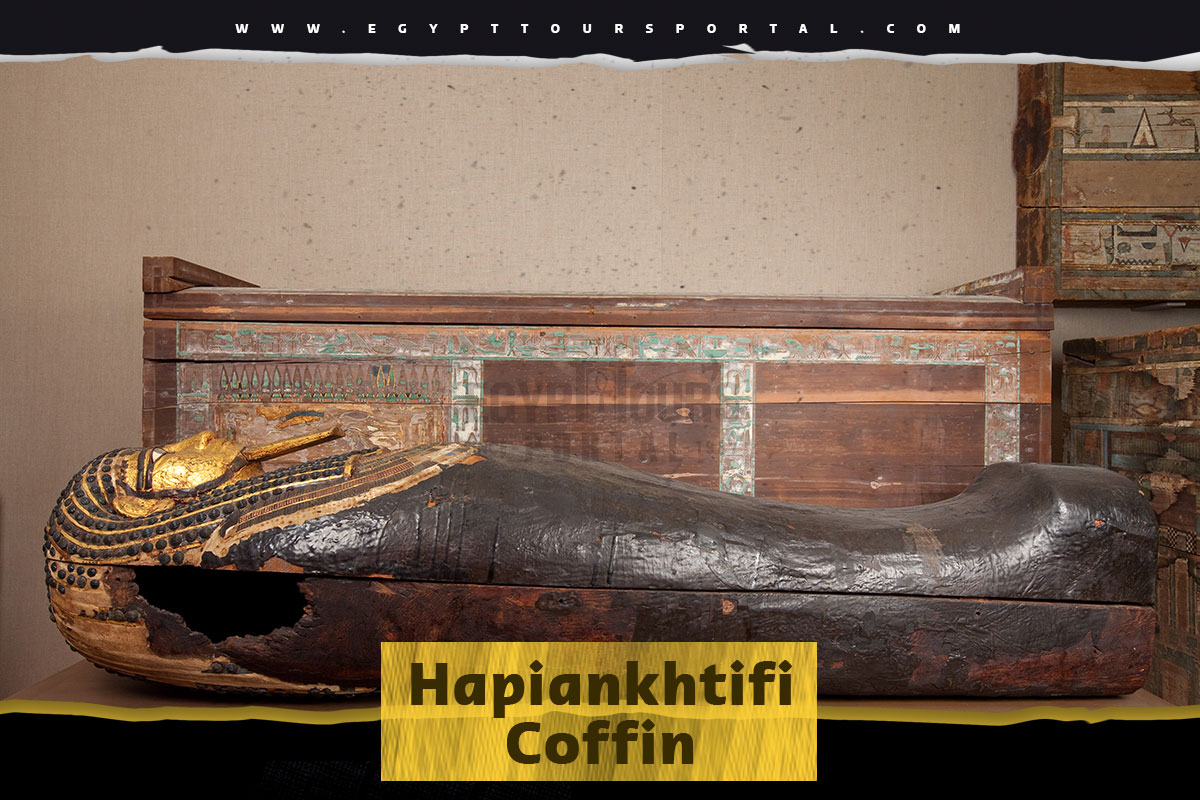
The tomb of steward Hapiankhtifi at Meir yielded an elaborate discovery dating to the 12th dynasty of the middle kingdom between 1981–1802 B.C.: a large outer coffin containing two nested smaller coffins—an anthropoid one and a rectangular one. The outer coffin's exterior features inscriptions and vertical bands of text, along with niches resembling textiles.
The purpose was to aid Hapiankhtifi's transition to the afterlife. Inside, an object frieze depicting various items, along with hieratic spells from the Coffin Texts, aimed to guide him eternally. The smaller inner coffin, also housing an anthropoid one, was adorned with simpler decorations. Notably, Wedjat eyes and colorful niches on the coffins emphasized their role as both a dwelling and a divine space for the deceased.
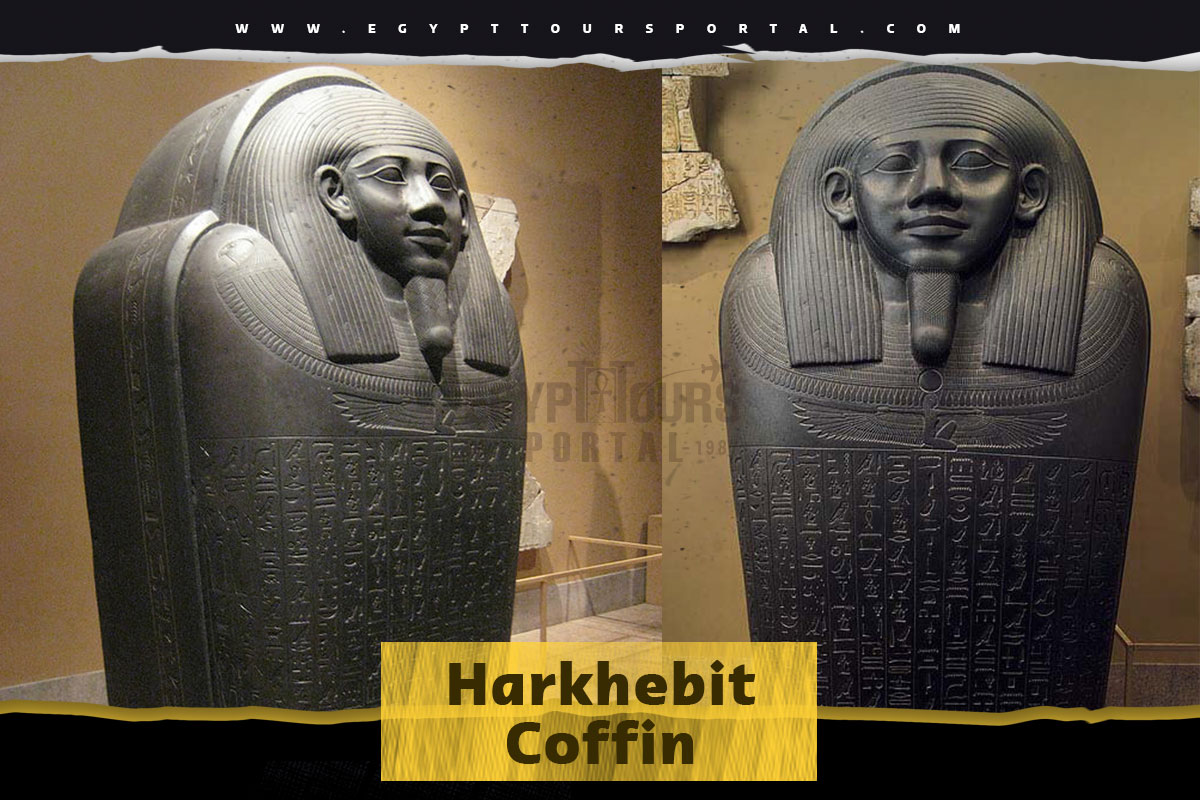
Horkhebit was a prominent figure in the early 26th Dynasty between 595–526 B.C., and held prestigious titles like "Royal Seal Bearer" and "Chief Priest". His tomb, situated in Saqqara's Late Period cemetery, had a deep shaft leading to a spacious chamber containing an anthropoid sarcophagus. The excavation of his tomb in 1902 revealed a gilded cedar coffin within the sarcophagus, along with a decomposed mummy adorned with a silver-gilded mask, gold finger and toe pieces, and various amulets.
The sarcophagus was acquired by the Metropolitan Museum from the Egyptian government and is part of a group characterized by plump faces and unarticulated bodies, dating from Psamtik II to Amasis' reign. The intricate hieroglyphs on the sarcophagus were left roughly carved, possibly for future painting. The lid features a passage from the Book of the Dead. This sarcophagus stands out as a masterpiece of late Egyptian hard-stone carving.
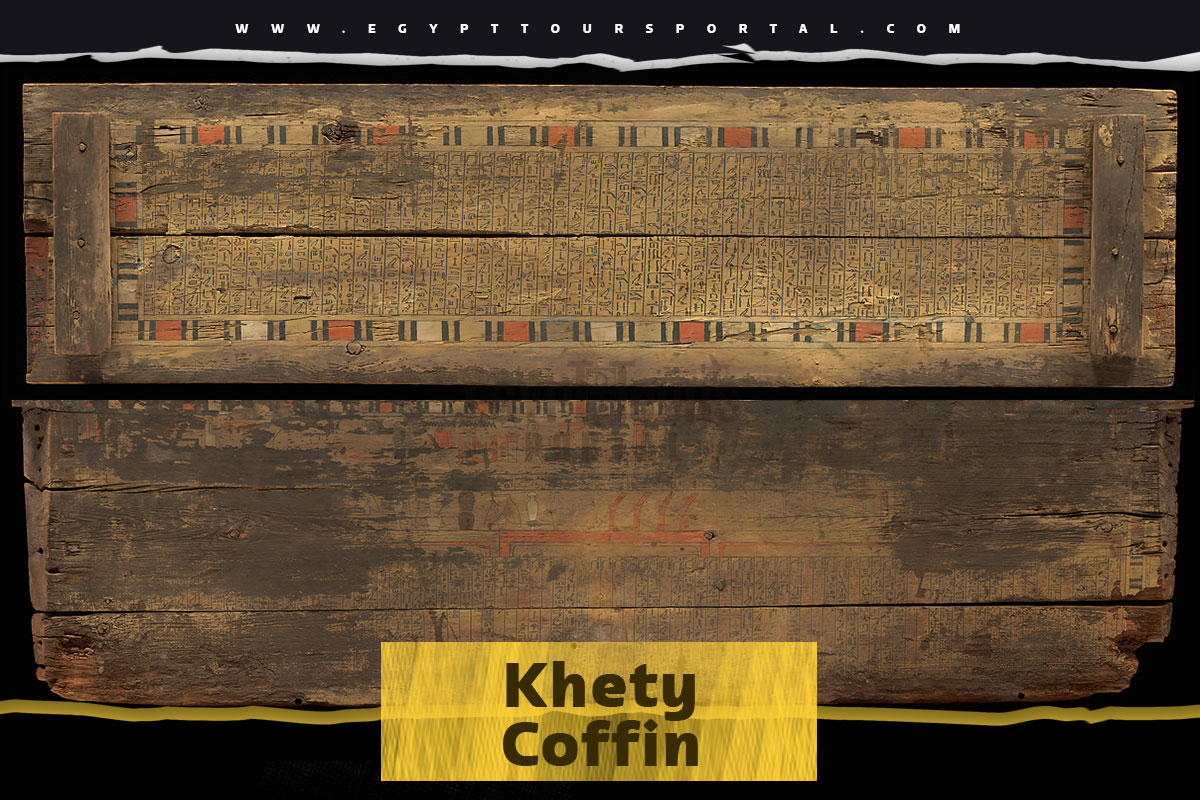
The wooden coffin of Khety was the Overseer of the Storehouse that follows a style seen from the mid-12th Dynasty between 1919–1800 B.C. Its exterior design is fairly simple, featuring horizontal and vertical bands of inscription. Unfortunately, the pair of Wedjat eyes on the east side has been damaged.
The lid is composed of two planks and is inscribed with Coffin Texts in a cursive script, along with false door and offering table depictions on the east side, while the west side illustrates clothing, toilet items, and a headrest placed on tables and stands. The coffin's interior floor contains text within blue bands resembling water, and the head and foot ends are adorned with images of sacred oil vessels and sandals.
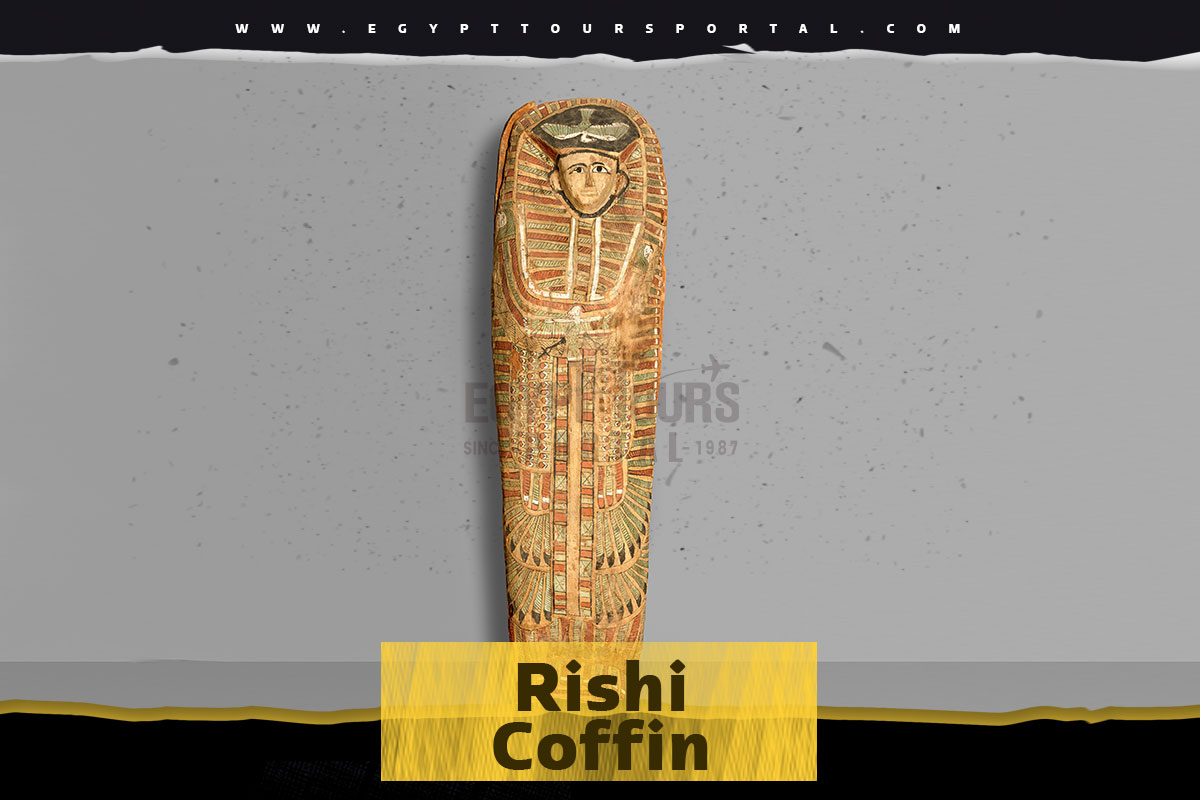
This rishi coffin was found in a rock-cut chamber near a Middle Kingdom tomb. Identified by the feather pattern on the lid, it's a type that emerged in the late Middle Kingdom and was prevalent during late Dynasty 17 and early Dynasty 18, particularly in Thebes. The coffin's lid features a triangular face with a royal nemes headdress in reds, greens, and black, framing a vulture on top of the head. This re-appropriation of royal imagery reflects the deceased's association with Osiris and mortuary rituals. The mummy-like form relates to mummification. The neck holds a wide festival collar with falcon-head terminals and a vulture figure above, grasping an ankh and a shen ring, symbolizing life and eternity.
The lid's body displays three feather types: horizontal, vertical "Tail", and concentric ovals creating wing-like patterns. Interpretations of the feather motif vary, including suggestions of a royal coronation corselet or an association with the deceased's ba, a bird-like aspect of the individual. The coffin's exterior is black, while the interior remains unpainted. The coffin was carved from a log, and a bundle of oily linen was discovered inside at the foot end.
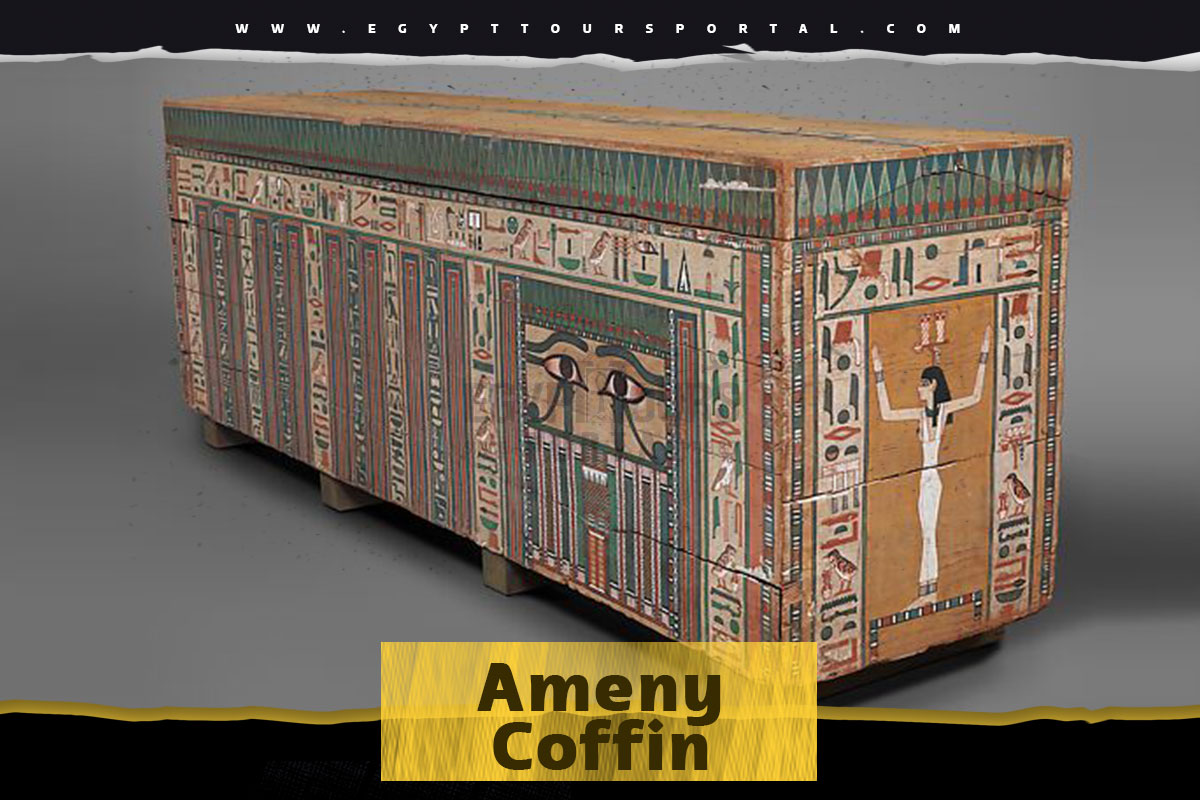
The coffin's owner, Ameny is described as the "son of a member of the elite" in the lid inscription dating to the 12th dynasty between 1981–1802 B.C. His mummy, now at the Peabody Museum, indicates he was elderly at death. The inscription pleads with Anubis, "Lord of Sepa", for a smooth passage to the afterlife.
The coffin's painted decoration depicts doorways surrounded by elaborate niches, resembling "False Doors". These symbolized a spiritual exit for the deceased to receive offerings. An eye motif above one doorway corresponds to the mummy's eyes, combining human and falcon features (Wedjat eye) for protection and communication. This element represented a connection to the world and the sun's rise.
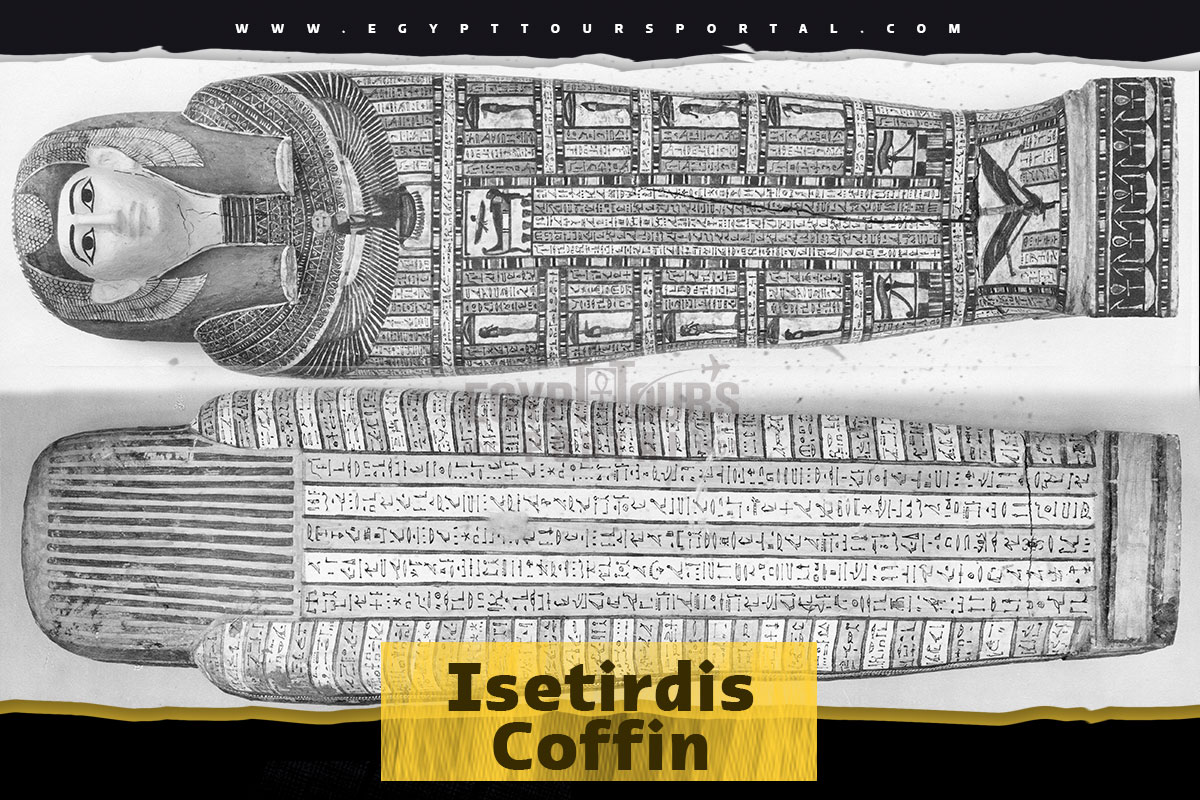
This coffin was fashioned in the style of the 26th Dynasty between 664–525 B.C., and bears inscriptions for Isetirdis, a Lady of the House. It features depictions of protective deities and spells. Interestingly, upon discovery, the coffin did not house a mummy; instead, fragments resembling embalming materials were found within.
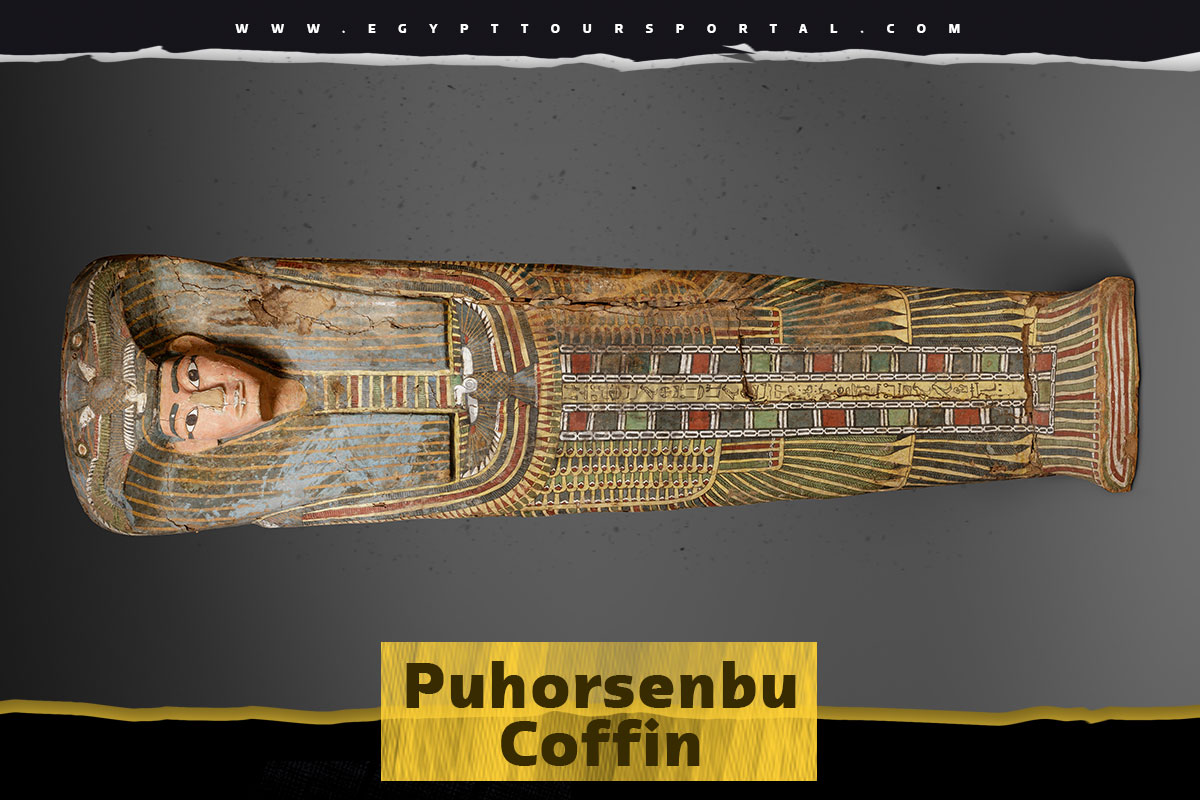
This coffin dates to Dynasty 17 and early Dynasty 18 between 1580–1479 B.C. and exemplifies the rishi style remarkably well. The face is intricately modeled and painted a soft pink. The feather pattern, along with the broad collar featuring bead strands mirroring the vulture pendant, has transformed into abstract designs, creating an illusion of the bird's wings extending along the mummy's shoulders.

During the New Kingdom, specifically in Dynasty 18 under the joint rule of Hatshepsut and Thutmose III (around 1479–1458 B.C.), a finely crafted pinewood anthropoid coffin was found. Belonging to the singer Hormose, it was discovered amidst limestone debris near Senenmut's tomb chapel (TT 71). The coffin is adorned with vibrant paint, the face is covered in gold foil and the eyes are made of alabaster and obsidian, set within ebony sockets. Hormose's lute and two forked wooden staves, one featuring a bronze ferrule, were found adjacent to the coffin.
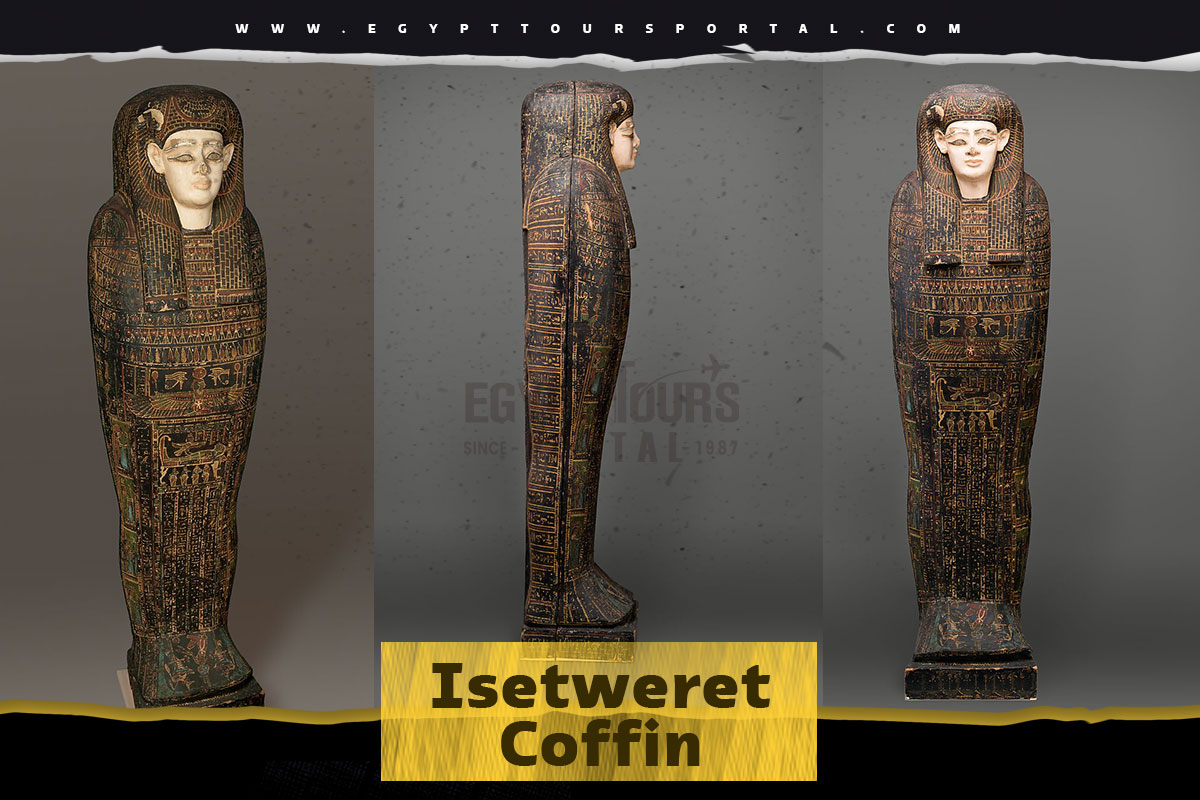
This coffin belongs to Isetweret from the Ptolemaic Period (400–250 B.C.). The inscription identifies her as the daughter of the priests Wenpasherymin and Iretenhapiaat. She resided in Akhmim, a significant cultural and religious hub of that time linked to the deity Min. The coffin's well-sculpted face boasts vibrant colors that contrast with the dark hair and body.
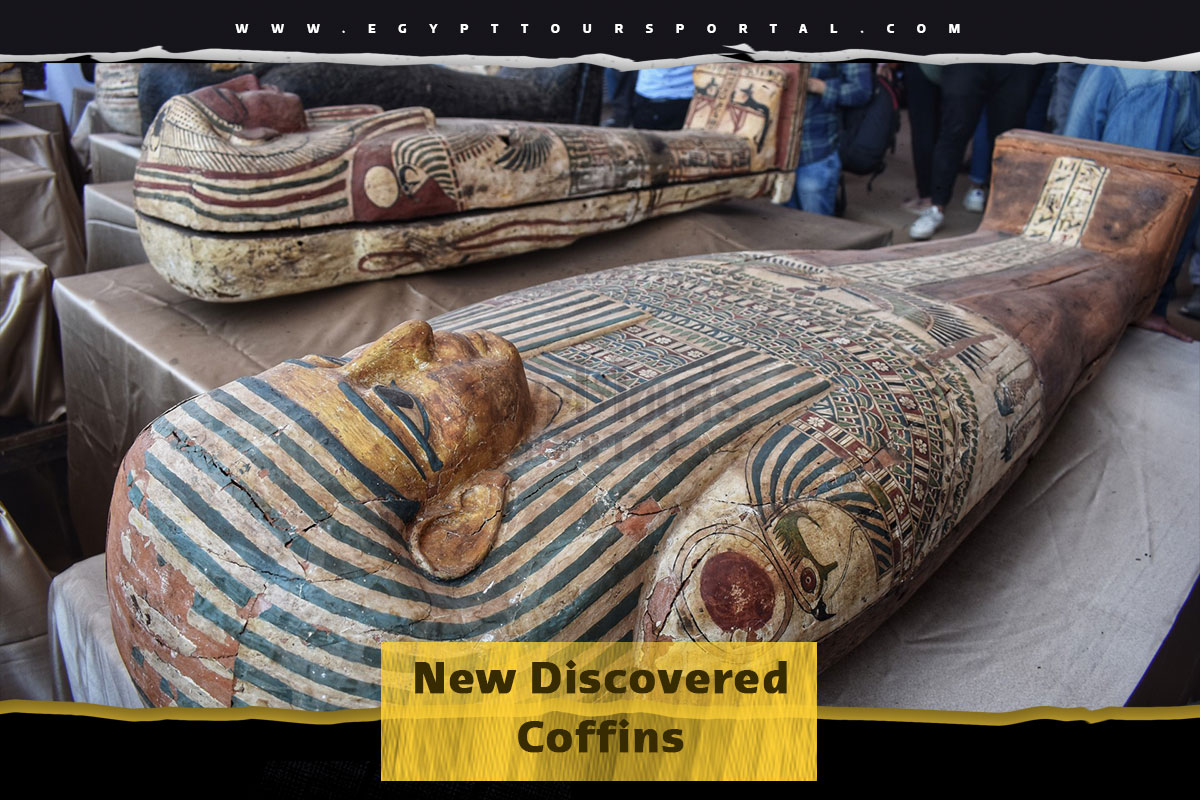
One of the biggest discoveries that came to light was when Archaeologists in Saqqara in May 2022 made a significant discovery, unearthing a trove of ancient Egyptian coffins and bronze statues dating back to around 500 BC. Among the findings are painted wooden coffins and bronze statues representing deities like Anubis, Bastet, Min, Amun Osiris, Nefertum, Isis, and Hathor. The collection also includes a headless statue of Imhotep, the architect who built the Saqqara pyramid. The excavation yielded 250 well-preserved coffins that reveal a great deal of facts, 150 bronze statues, and various objects from the late period around 500 BC. Musical instruments like a sistrum and bronze vessels for Isis worship were also found. The coffins contained mummies, amulets, wooden boxes, and an intact papyrus, possibly containing verses from the Book of the Dead.
The findings will be showcased at the Grand Egyptian Museum. In 2019, a number of Archaeologists have uncovered over 20 ancient wooden coffins close to Luxor. These coffins, adorned with vibrant decorations, were found in the Theban necropolis of Asasif on the west bank of the River Nile. Arranged in two layers, the upper coffins lay across the lower ones. The discovery is deemed among the most significant in recent times by Egypt's antiquities ministry. The Asasif necropolis holds tombs that date from the Late Period (664-332BC), along with earlier tombs from the 18th Dynasty (1550-1292BC) of the New Kingdom, which included prominent Ancient Egyptian pharaohs such as Tutankhamun and Hatshepsut.
One of the most mysterious coffin findings that was made public in 2018 is all about a massive 30-ton sarcophagus made of black granite that was found at a construction site in Alexandria, Egypt. It remained hidden for thousands of years. Upon opening it, archaeologists discovered the remains of three mummies. Initial assumptions that they were military officers were debunked by DNA analysis, which revealed one of the bodies to be that of a woman. Unlike the ornate sarcophagi of the wealthy, this one lacked inscriptions and burial items, except for a small gold artifact and three gold sheets. The absence of clear information about their identities and the time they lived has created an intriguing archaeological mystery, which experts are eager to unravel. A lot of discoveries have been made all across Egypt that showcase some of the most magnificent coffins from a number of time periods.
Coffins offer a golden magical glimpse into social, religious, and economic shifts. Beyond decorative motifs, changes in material and construction reveal trade, international relations, and economic aspects. Researchers in modern times have investigated coffin reuse, highlighting their significance across Egyptian history. With our incredible Nile River Cruises and Egypt guided tours, everyone can get a magical insight into untold extraordinary riches that gained fame and recognition as one of the most breathtaking pieces of art in the history of mankind.
Private 4 Days Cairo Tour Packages for Canadian Travelers 4 days Cairo Egypt Tour pa...
Tour Location: Cairo – Giza...
5 Days Cairo and Alexandria Tour Package For Canadian Travelers 5 days Cairo and Ale...
Tour Location: Cairo/Giza/Alexandria...
6 Days Cairo, Luxor & Aswan Tour Package For Canadian Travelers 6 days Cairo, Lu...
Tour Location: Cairo/Giza/Aswan/Luxor...
Amazing 7 Days Cairo and Hurghada Holiday for Canadian Travelers 7 Days Cairo & ...
Tour Location: Cairo – Giza – Hurgh...









